| |||||||
| Search Forums |
| Advanced Search |
| Go to Page... |
 |
| Search this Thread |  1,523,358 views |
| | #1 |
| Team-BHP Support  | Toyota Fortuner : Official Review The Toyota Fortuner has been launched in India at a price of between Rs. 25.92 - 31.12 lakhs (ex-Delhi). What you'll like: • Contemporary styling & imposing street presence • Tough build. Toyota body-on-frame UVs are known to have very long lives • Powerful diesel and smooth petrol, with user-selectable driving modes too • Interiors are much improved. Cabin is practical & user-friendly • Loaded with features like Bi-beam LED headlamps, powered tailgate, paddle shifters & more • Impressive offroad capability (by big SUV standards) • Top-notch safety kit. 7 airbags, ABS, ESP, TC, hill assist, ISOFIX & 3-point seatbelts for all • Toyota's excellent after-sales quality, fuss-free ownership experiences, low service costs & up to 7 years of extended warranty coverage What you won't: • Pricey! More expensive than the better-equipped & equally-competitive Ford Endeavour • Missing sunroof, lumbar adjustment, front parking sensors, auto-wipers etc. • Ride quality – although improved – is still far from plush. You’ll feel the bumps • Cost-cutting in a couple of areas; some interior plastics, ICE audio quality, camera display… • Diesel’s short service interval of merely 5,000 km! Inconvenient for those with high usage • Petrol variant is a guzzler. We saw merely 6 – 7 kmpl on the AT • No longer a full-time 4x4. Also, 4x4 carries a Rs. 2.5 lakh premium on the MT (3 lakhs on the road) • No cheaper / smaller diesel variant like the Endeavour 2.2 & ol’ Fortuner 2.5 for the mass market The 2021 Legender & Facelift • Link to review 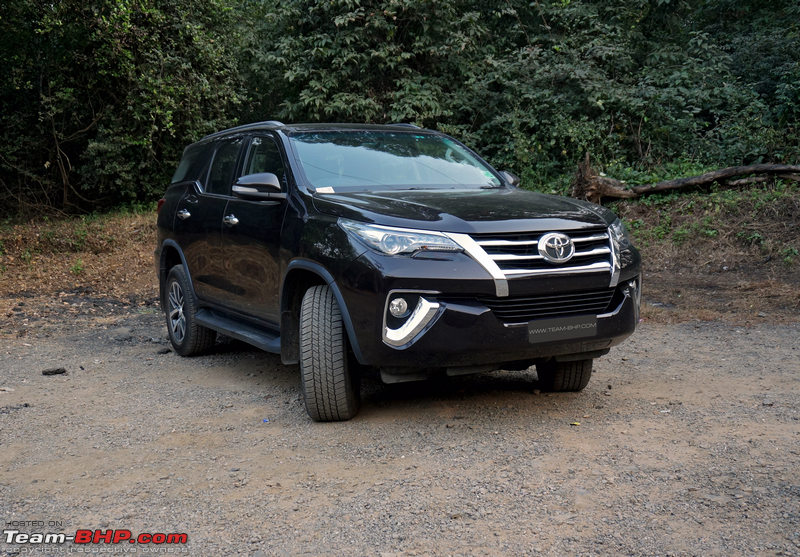 Last edited by Aditya : 15th March 2021 at 13:44. |
| |  (79)
Thanks (79)
Thanks
 |
| The following 79 BHPians Thank Aditya for this useful post: | akshay81, anupgangwar, AShubrah, AutoIndian, Avikbrio, BlackPearl, CarguyNish, carrot_eater, CEF_Beasts, chiefpk, ChiragM, Contrapunto, daretodream, darklord, debuda, dhanushmenon, DrANTO, dZired, ecosport rules, Flyer, GrammarNazi, Grand Drive, GTO, hemanth.anand, IronH4WK, Ithaca, Jaggu, JoseVijay, JTM, karan561, Karthik Chandra, Leoshashi, libranof1987, maddyguage, Maky, Manan_02, mroptimist, NiInJa, noopster, OrangeCar, parsh, phoenixash, planet_rocker, Prakritij, R2D2, ragh_bhushan, raptor_diwan, rav11stars, RavenAvi, roby_dk, rshanker, Rshreyansh, S.MJet, SaiSW, samabhi, Samurai, sayakc, scopriobharath, sdp1975, sgmuser, Sheel, Simat, Simhi, SmartCat, SnS_12, sri2012, sunny29584, swiftnfurious, T2luvroads, tazmaan, theexperthand, timuseravan, TOINGPOING, uday.ere, vaasu, vb-saan, Vid6639, vredesbyrd, Yeldo |
| |
| | #2 |
| Team-BHP Support  | Review Index: Exterior Last edited by GTO : 25th January 2017 at 16:46. |
| |  (31)
Thanks (31)
Thanks
 |
| The following 31 BHPians Thank Aditya for this useful post: | AShubrah, AutoIndian, carrot_eater, DrANTO, dZired, gkveda, GTO, IronH4WK, JoseVijay, Karthik Chandra, Leoshashi, Manan_02, Obi-Wan, parsh, phoenixash, ragh_bhushan, RavenAvi, Rshreyansh, Samurai, sgmuser, Sheel, Simat, SnS_12, sunny29584, T2luvroads, theexperthand, Toshi_A, uday.ere, vb-saan, Vid6639, Yeldo |
| | #3 |
| Team-BHP Support  | Exterior  Team-BHP’s sales threads over the years have shown how SUVs dominate over sedans in the D2 segment. When Toyota launched the first-gen Fortuner in 2009, this ‘Mini-Land Cruiser’ was an instant success, comfortably beating the Ford Endeavour and ageing Mitsubishi Pajero. We even called it the best 20 lakh SUV in our review then. Toyota's legendary reputation for making reliable cars backed by a strong, widespread service network helped the SUV stamp its authority on the segment. However, with time, the Fortuner had begun to feel awfully outdated. While it was still a handsome SUV, the 10-year old design, engineering & interior showed their age. No facelift would help, a new generation was the need of the hour. This 2nd-gen Fortuner was launched in Thailand in July 2015. However, the diesel ban of Delhi-NCR (the largest market for such cars in India) paid put to Toyota’s plans of bringing it last year. In fact, Toyota did not even display the vehicle at the Auto Expo in February 2016. Things have changed now. Toyota has finally brought the new Fortuner to India, an SUV which is a lot more modern and will continue to dominate the D2 segment. BHPian Shai100 first spotted it here - link to post. In November, Toyota reported factory dispatches of 1,924 units of the Fortuner, which is almost 4 times that of the Endeavour (562 units) - the next best-seller in the segment! This is despite the Fortuner being priced higher than the Endeavour. December saw 1,780 shipments (double that of the Endeavour). Sure shows the trust customers have in brand ‘Toyota’ and brand ‘Fortuner’. In terms of bookings, the SUV recently crossed the 10,000 mark. To make sure that the Fortuner is able to tackle any unforeseen diesel bans of the future, Toyota has also launched it with a 2.7L petrol, despite knowing that the market for big petrol SUVs is small. Both engines are available with manual and automatic transmissions. While the diesel version comes in RWD and 4WD variants, the petrol version comes only with a RWD configuration. Based on the Hilux pickup truck, the 2nd-gen Fortuner continues with a tough body-on-frame construction like the old car and uses the same ‘Toyota New Generation Architecture’ that underpins the Innova Crysta. The car measures 4,795 mm in length, 1,855 mm in width and 1,835 mm in height. This makes it longer and wider than the outgoing model. However, it sits lower than the old Fortuner. It is also smaller in dimensions than chief rival - the Ford Endeavour.  The Fortuner wears contemporary clothes and is arguably softer than the model it replaces. But make no mistake - she looks imposing in person. It has slimmer wraparound headlights and tail-lights, a smaller grill, a more aerodynamic front, a bonnet without an air scoop, slimmer windows and yes, additional chrome. Toyota has also given the car automatic self-levelling bi-beam LED projector headlamps, LED daytime running lights, LED tail-lamps and 18" alloy wheels (4WD). A combination of these features and the massive size ensure that the car has immense road presence. The fit & finish are good with tight and uniform panel gaps all over. The car feels solidly built & you just know that it can handle any kind of abuse one throws at it. It has a kerb weight of 2,140 kg (4WD Diesel AT) and this is evident when you try to lift the bonnet! At the same time, the doors feel rather light. They are thin and the metal flexes a little if you press it with your thumb. These will surely get dinged easily. Like its MPV sibling – the Innova Crysta - the paint job is very lustrous & shiny, although the orange peel effect is too prominent. Coming to safety, the Fortuner is equipped with seven airbags, 3-point seatbelts for all occupants, ABS + EBD, ISOFIX child seat mounts, traction control, vehicle stability control, brake assist, hill assist control and downhill assist control. The car has scored a 5-star rating in the Latin NCAP and ANCAP crash tests. Suffice to say, Toyota has you covered in this area. A contemporary face! Slimmer headlamps, narrower grill and acres of chrome are the most evident features of the new Fortuner. Seeing this in the rear-view mirror makes people give way: 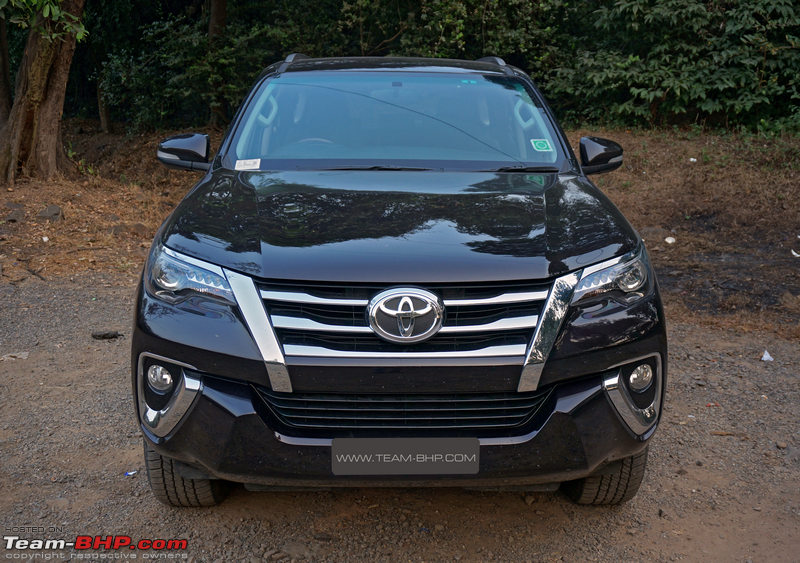 Tail-lamp clusters are slimmer as well, with a chrome strip connecting them. Thankfully, the use of chrome is a lot less liberal than at the front. Spare wheel (carried under the body) is clearly visible:  Looks like a modern & butch SUV. The wheels are massive and the metal area large. Windows are slimmer, and there is slim plastic cladding on the wheel arches. No plastic on the body however:  Fenders bulge out to provide a muscular look to the car. Tough, precise build means a l-o-n-g life. Toyota body-on-frame diesels are known to outlast their owners:  Design is sleek and features more cuts & creases than the outgoing model. Overall glass area has shrunk – not cool. Chrome strip runs along the window line from one A-pillar to the other…around the rear of the SUV! 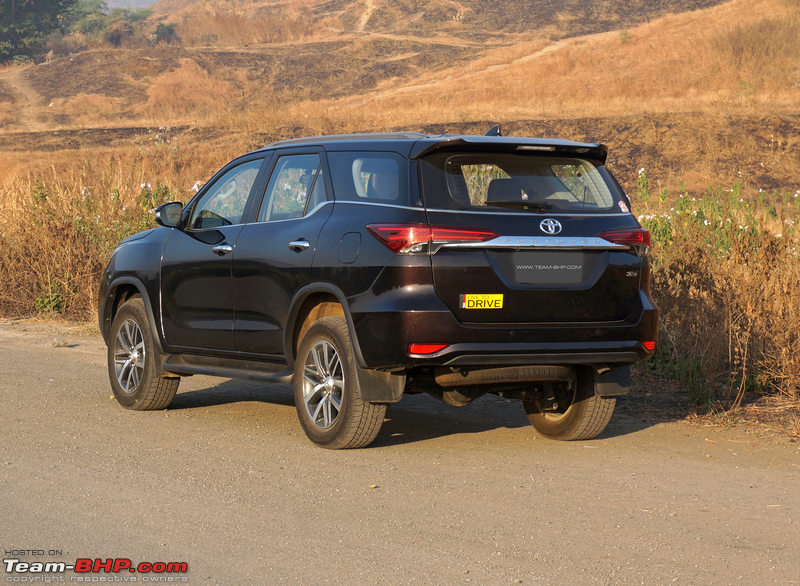 Slim & futuristic wraparound headlamps sweep back a long way. They consist of self-levelling, automatic, bi-beam LED projector headlamps & LED DRLs. Headlamps have a follow-me-home function. For this to work, the car must be switched off with the light stalk in auto position. Don’t miss the chrome strip on top. Headlamp washers would’ve been a useful addition for this expensive highway horse:  The term ‘Bi-Beam’ is engraved on the side of the projector headlamp:  Image with all the lights in action. Notice the eyebrow-like extensions of the DRLs: 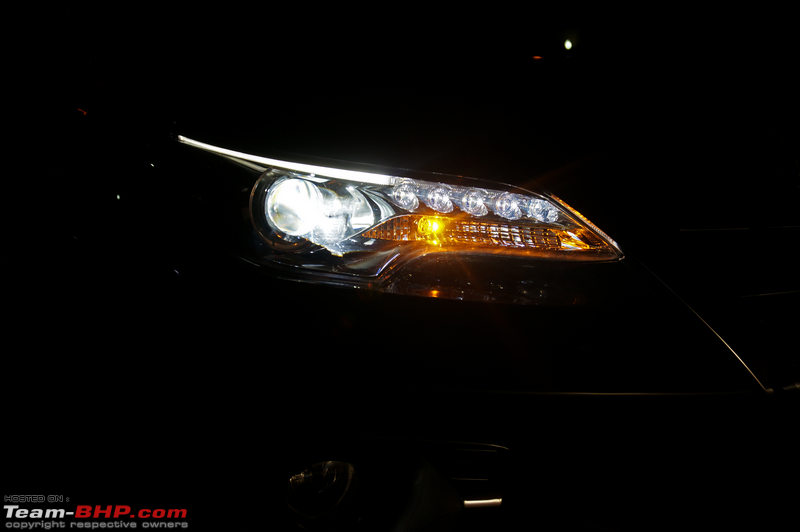 DRLs are bright & prominent, even during the day:  Irregular gap between the headlight and bumper. One of the rare misses in overall fit: 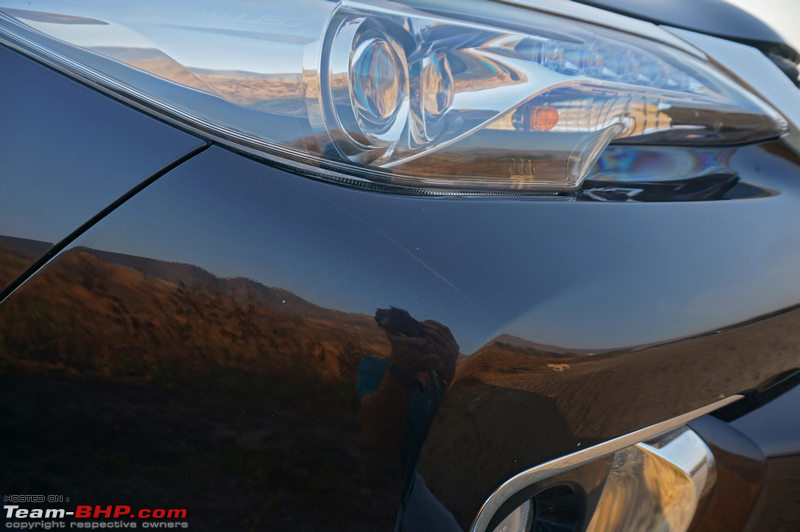 V-shaped grill features three horizontal chrome slats, two thick vertical chrome bars on the sides and a large ‘T’ in the middle: 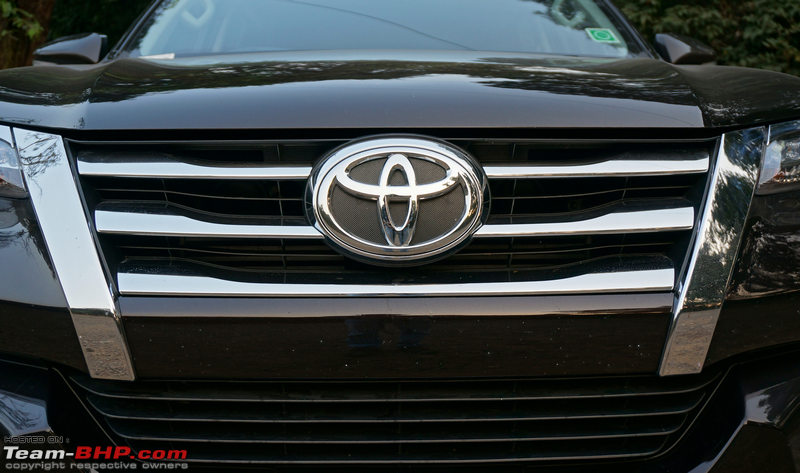 Check out the smart detailing on the black background:  Front bumper has many creases. Short but wide air dam with horizontal black slats. Foglamps are located at the extreme ends and get flashy housings with chrome borders:  Round halogen foglamps are reasonably powerful. Notice how thick these chrome accents are!  Underbody gets a good deal of protection at the front. Notice the two flaps at the front, behind which, are a pair of tow-hooks:  Large bonnet has two prominent creases. Air scoop of the old Fortuner is lost:  The wipers are extremely sculpted and the one on the driver's side is a lot longer. Both the blades are split into 3 pieces to allow more flex (superior sweep):  Windshield washers are hidden neatly under the bonnet:  Both windshield washers squirt out effective sprays (rather than jets) of water. The big wipers have a good sweep:  Uniform panel gaps for the most part:  Aero flaps at the front only. Cars like the Hyundai Creta use them at the rear too:  Very ugly. Naked wheel wells don't offer the kind of insulation you'd expect at this price point. Drive over a gravelly road and you'll hear stones & pebbles hitting against the bare metal. This one is the partially-clad front…  …rear is fully nude!  4x4 variants get dual-tone 18” alloy wheels with 265/60 section Bridgestone Dueler H/T tyres. The wheels look good, but the H/T tyres are sure to limit offroad performance. Tyre replacement costs of such a big size will be steep:  RWD variants are fitted with dual-tone 17” alloy wheels with a different design and ironically, 265/65 section A/T tyres! How can the 4x4 get H/T tyres and the 4x2 A/T? This size is the same as what was used in the old Fortuner. 13 mm taller sidewall means the RWD variants will offer better ride quality. Ventilated disc brakes are provided on all four wheels of the Fortuner…finally! After years of complaining about the Fortuner’s rear drums:  Dual-tone body colour + black ORVMs with integrated blinkers:  ORVMs house useful puddle lamps underneath!  See the fins on its mounting panel? Toyota says it's there for aerodynamic reasons (two similar fins are there on the tail-lamp as well). Click here to see an explanatory image shared by Toyota:  Door handles are long & dipped in chrome. Nice touch - even the request sensors are matched in chrome (the request sensor is usually black). Yes, there's a request sensor on the passenger's door as well. Only the one on the right gets a keyhole:  Side step is wide and well integrated into the design. It is very useful as the floor of the car is high:  Zooming in on the paint to illustrate its orange peel effect. Way too evident, not cool Toyota!  B, C and D-pillars are blacked out to provide a floating roof effect. Thick pillars and small glass area limit all-round visibility:  Window line rises slightly at the C-pillar, courtesy of this kink. Chrome strip also gets thicker here:  C-pillar is very thick and third row window is smaller than before, limiting the light entering the cabin:  Ribbed roof for added structural integrity. We wish a sunroof was provided:  Roof rails are sturdy and firmly fitted. They have a satin finish:  Big spoiler fits nicely into the overall design:  Sharkfin antenna sits at the very end of the roof section:  Sleek tail-lamps are LED units with a much more contemporary wraparound design than the large ones of the outgoing model:  How the tail-lamps jut out. Don't miss the 2 aero fins I spoke of earlier:  A closer look at the detailing in the tail-lamp cluster. Notice the recess under the tail-lamp where the chrome strip ends - an area where dust is sure to gather:  With all the lights in action: 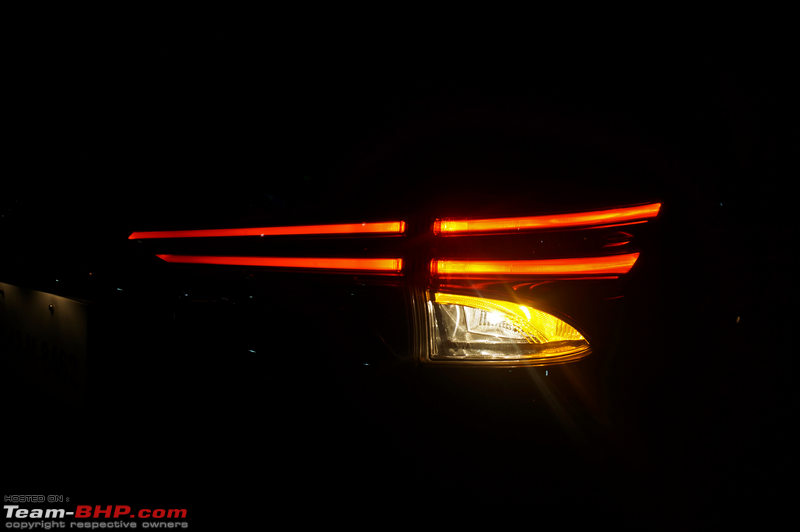 HMSL is mounted on the spoiler. It is white with red LEDs (some cars have it the other way around):  Rear washer is superbly hidden from view (it's on the inside edge of the spoiler). Good that all variants have it since the rear windscreen gets really dirty in SUVs:  Thick chrome garnish with Fortuner branding connects the two tail-lamps. Above, you’ll see a thin chrome strip running along the windshield’s base:  Rear camera is very accurate! It's tucked away above the numberplate (on the left). In a car as long, you're going to need it:  Electromagnetic boot release button on the left with the 'lock' button on the right. With the smartkey in your pocket, simply press the boot release and the tailgate will open (long-press button to close the tailgate). Once done, press the round 'lock' button to secure the vehicle. Be sure to lock it this way, else the cabin will be accessible to anyone:  Funky ‘Sigma 4’ badge reveals that the car is equipped with a 4x4 system. Apart from this, there is no badge on the body that denotes the engine or variant:  RWD variants are clean:  Rear bumper rises all the way up to the tail-lamp clusters. There is a black plastic insert on the lower edge, with reflectors at both ends. Only two parking sensors provided in the middle area of the bumper, which means one has to keep an eye out on the corners. On a car as expensive - what was Toyota thinking? The bumper doesn’t feature a cut-out for the exhaust pipe. The pipe peeps out from below the bumper on the right:  A closer look at the reflector. Shockingly, no rear foglamp! At this price point, I would have expected one:  Rear air-con's AHU is located in the rear right corner. The 'Air Handling Unit' consists of a blower and second small evaporator core:  Spare is mounted under the vehicle. All variants get a full-size alloy spare. That chain is loose, but you don't hear it banging against the wheel inside: 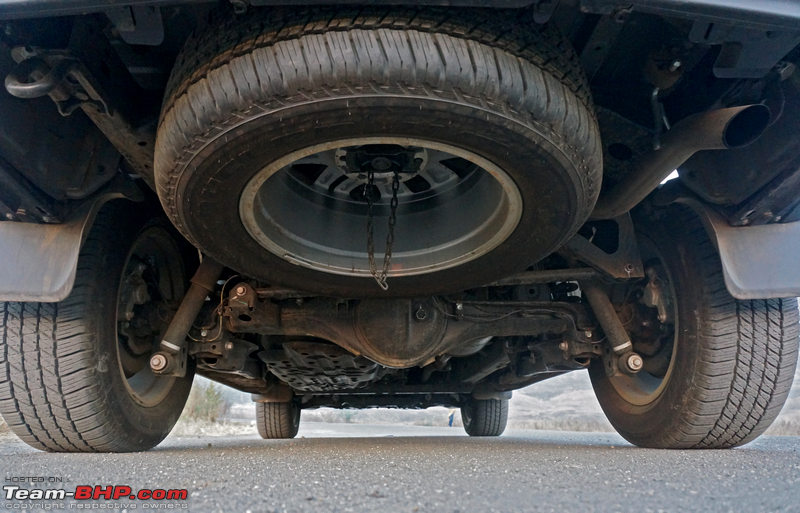 Tow-hook is located on the left. Mudflaps are standard: 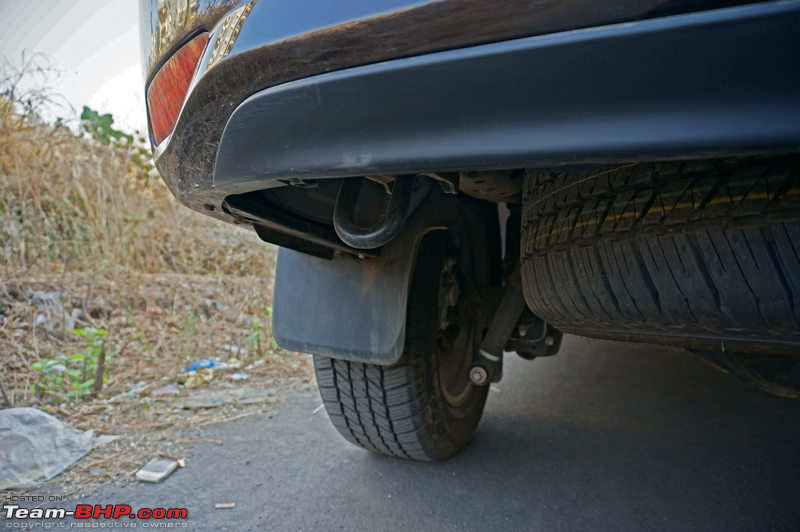 A cable eye on the right:  80 liter fuel tank is oddly shaped and has protection on the underside: 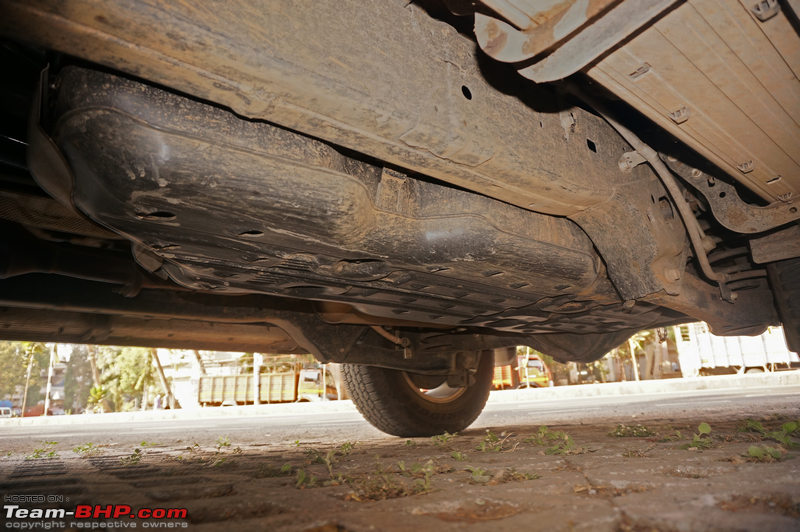 Fortuner uses a double-wishbone suspension at the front:  The new Fortuner is longer & wider than the outgoing car. Looks so much more substantial than the ol’ truck. If the outgoing Fortuner was 'classic Toyota', the new Fortuner is Lexus-like: 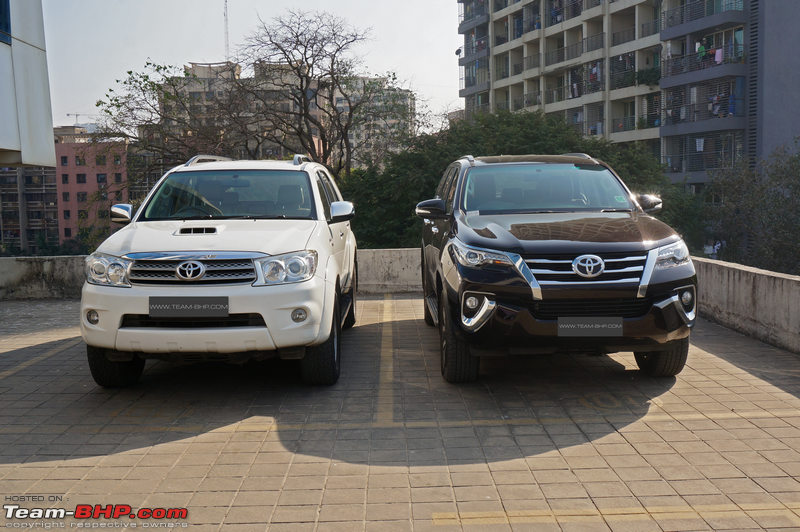 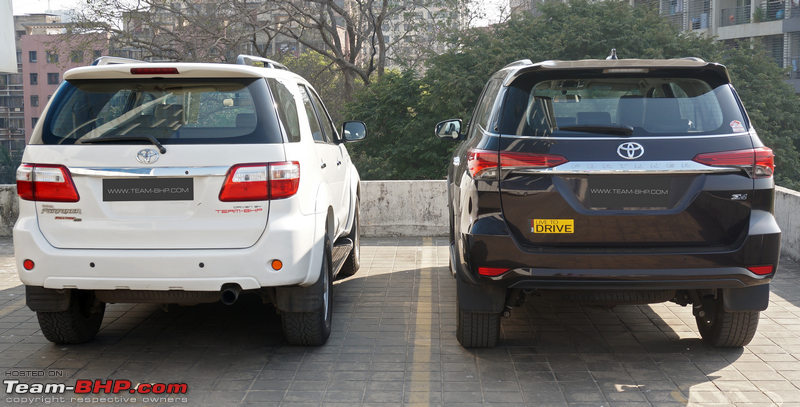 Just like we commented in the Innova Crysta review, this doesn't look like an all-new platform. Rather, it's the same old chassis of the outgoing Fortuner, suitably beefed up of course. Also explains why the new Fortuner is so much heavier than the outgoing car. Weight penalises on-road / offroad behaviour & performance and there's no doubt that the Fortuner is too F-A-T (Endeavour is even more obese):  Last edited by GTO : 28th January 2017 at 11:03. |
| |  (56)
Thanks (56)
Thanks
 |
| The following 56 BHPians Thank Aditya for this useful post: | Akshay1234, akshay81, AutoIndian, Avikbrio, avinash_clt, CarguyNish, carrot_eater, CEF_Beasts, Contrapunto, darklord, dkaile, Dr.AD, DrANTO, ecosport rules, espraveen, GrammarNazi, GTO, GTp0wer, heavenlybull, InControl, IronH4WK, Jaggu, JoseVijay, JTM, Leoshashi, libranof1987, maddyguage, mroptimist, Nohonking, noopster, parsh, phoenixash, Prakritij, PrasunBannerjee, ragh_bhushan, RavenAvi, roby_dk, romeomidhun, Roy.S, rshanker, Rshreyansh, S.MJet, sayakc, scopriobharath, SDP, Sheel, Simat, sleepyk, SnS_12, sunny29584, supertinu, uday.ere, vaasu, vb-saan, Vid6639, vredesbyrd |
| | #4 |
| Team-BHP Support  | Interior - Front  The front doors open and shut in a triple-stage action. They are not as heavy as you'd expect them to be on a car that weighs 2,000+ kilos. While they open wide enough, ingress & egress aren’t easy, thanks to the sheer height of the vehicle. The floor of the car is about 24 inches off the ground and the running board is wide, which means climbing in is difficult. To help with the task, a grab handle has been provided on the A-pillar, in addition to the side step. Even then, the elderly will find it pretty tough to get in and out of the vehicle. GTO's Mom, a senior citizen, needed a small stool to be placed on the ground before she could get in. The interiors of the new Fortuner are so much more ‘with the times’ than the outdated cabin of the outgoing model. Toyota has gone with a black and brown colour theme, with silver and piano-black inserts at various places. This theme is a good choice, particularly for those who would like to take their vehicles offroading, where a lighter shade will get soiled much easily. That said, beige should have been an option for those who like things brighter. The pillars and roof liner are whitish grey and the glass area is large enough to ensure that adequate sunlight enters the cabin. The cabin is sufficiently wide and occupants won’t feel too close to one another. While the leather on the dashboard and door panels is soft, there is not soft-touch plastic used anywhere. Fit & finish are flawless and all buttons & switches feel like they are built to last 300,000 km. While the quality of most parts is acceptable, there are certain bits that feel out of place on a car this expensive. These include the glovebox lid, low-grade cupholder plastic & sunglass holder. On the other hand, the sunvisors are draped in a soft cloth, which feels premium to the touch. Overall, the cabin has a mix of average-feeling & nice-feeling parts. The interiors have been screwed together with absolute perfection. Nothing moves or shakes and nothing is loose. 'Built to last' is the term that comes to mind. What's more, the cabin is very practical. It offers sorted ergonomics, space, lots of storage and many likeable features. You'll be at home within minutes of stepping inside this user-friendly cabin:  It's a nice & tall driving position. Shorter folk will need to crank the seat up as they'll find the dash to be high. You can see a fair bit of the bonnet from the driver's seat. However, you cannot see the edges, as the bonnet slopes down:  Cowl above the instrument cluster is draped in leather. Nice. While it is soft, it does not feel very rich: 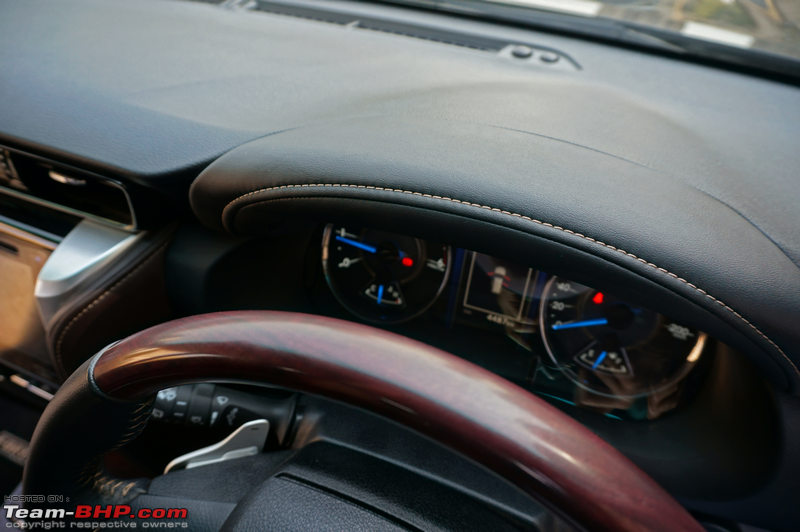 Leather-wrapped steering with thumb contours is chunky and nice to hold. It has a wooden insert at the top (which offers sufficient grip) and a silver insert on the lower spokes. On the flip side, the leather cladding is rock hard. I would've preferred softer material being used. Hornpad is light to press and when you honk, you'll hear that familiar Toyota horn: 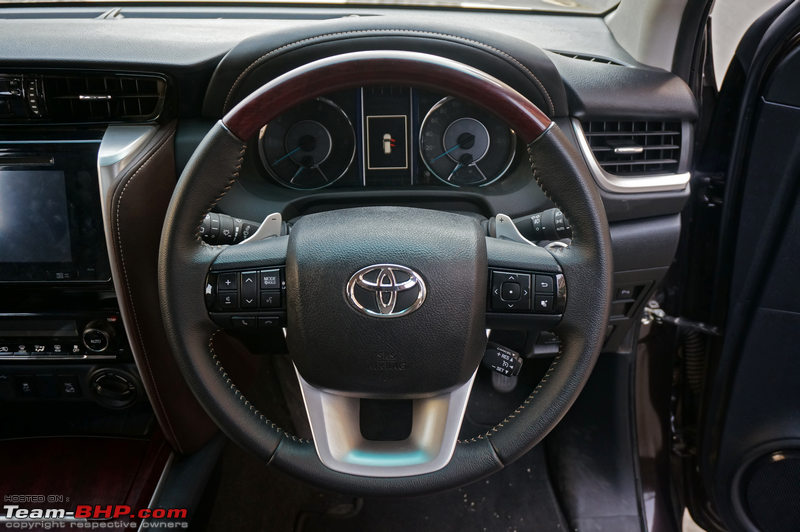 Steering-mounted buttons are well-sized (including the fonts). Notice the voice command button. 'Mute' has been provided on the steering wheel, although it's a major fail in terms of usability. Having any long-press button on a steering isn't cool and Toyota should've known better. You have to long press it to mute & unmute. When you mute, the track is paused. If you short press the same button, the audio system will go to a different mode (radio / USB / Bluetooth etc.):  Play with the MID using the buttons on the RHS. 4-way scrolling and back button make things easy. On the bottom right is a customisable shortcut key. You can set it to quickly access whatever MID screen / feature you use the most. Innovative:  Lovely silver paddle shifters on either side of the steering - one on the left is for shifting down and vice versa. They are large and a joy to use (especially in the petrol which offers more revs to play with):  Sturdy paddle shifters are perfectly contoured for your fingers to fit in:  Cruise control is provided on all variants except the 2WD M/T. I personally don't think it's of any use in India, yet I'm aware that some BHPians are fans of the feature. To them, the AT + cruise control combination might be tempting:  Zooming in to show you the stitching pattern of the steering:  The steering offers tilt & telescopic adjustment. Sadly, both have a limited range. While the tilt adjustment will still suit 99% of drivers, the telescopic adjustment isn't enough. 6 footers and those with a laidback driving position will wish that the steering came out more:  Instrument cluster consists of a large tachometer on the left, speedometer on the right and analogue temperature + fuel gauges in them respectively. While the numbers are backlit in white, the needles are backlit in blue. The readability of this instrument cluster is very good, even under direct sunlight. Has two vertical blue lines for effect. While the diesel's redline starts at just under 4,500 rpm…  …the petrol's redline starts at just over 5,500 rpm: 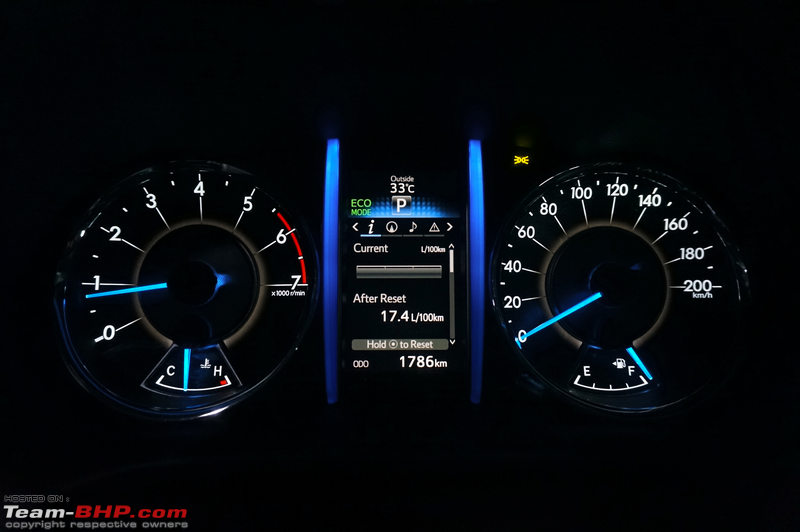 Ugly stalk sticks out of the instrument cluster - keep it pressed to toggle through the odometer + trip meter and adjust the brightness levels:  The well-sized TFT colour MID. In this image is all the data shown on the 1st information screen (accessible as you scroll down the 1st screen). Temperature, real time & average fuel economy (real-time shown graphically here), distance to empty counter and average speed. The graphical 'Eco indicator' & 'Eco score' are unique! Some of us are obsessed with 0 - 100 times; others are passionate about FE. The latter will love these meters. Not only does your driving style get an 'Eco Score', the system also rates you on starts (easy acceleration), cruising and braking (hard braking is a no-no): 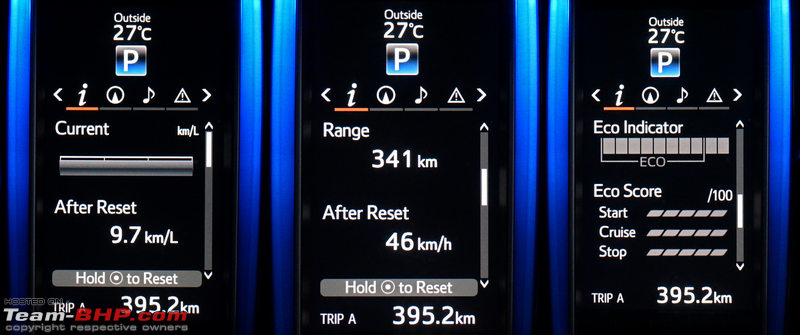 Scroll to the right and you'll see a digital compass (also shows street name when you are driving), music screen (can choose source) & warning messages. Phone call & cruise control info is displayed on the MID as well:  The settings only have to do with the MID; nothing vehicle specific (e.g. auto-locking doors) or for the lights. You can switch ECO on or off, set your favourite screen (shortcut button on the steering) and customise the trip meter display (how values are displayed & calculated):  You can also individually customise Trip Meter B! Next, choose whether navigation & phone prompts come up on the MID, select the colour theme (same options are available on the audio head-unit) and enter the fuel price & normal FE (against which ECO gains are calculated):  The MID also displays the specific door that is open. While it indicates if the tailgate has been left open, there is no such warning for the bonnet. Check video here - it shows you the motion of the door being opened / closed:  Thick stalks give positive feedback and are great to use. Fortuner has auto headlamps which work like a charm. At this price, I would've expected auto rain-sensing wipers too:  Keyless entry & go is a part of standard equipment. Chrome-ringed engine start button is backlit in a cool blue: 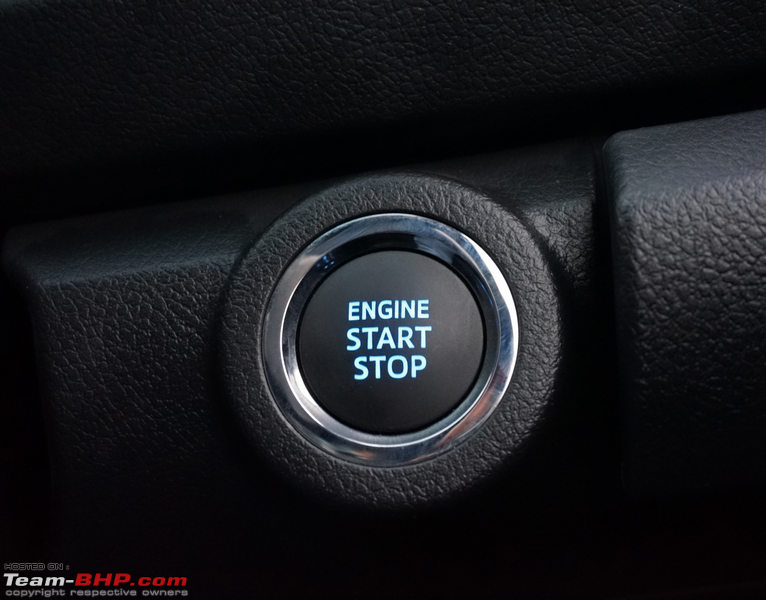 Plastic panel covering the regular ignition switch has a protrusion that looks u-g-l-y:  Unlike the Innova Crysta, the Fortuner has symmetrical air-con vents. The side vents have thick silver accents while the air flow direction controller gets a dash of chrome. The vents can be shut by moving the controllers to the extreme ends (extreme right for right vent and extreme left for left vent): 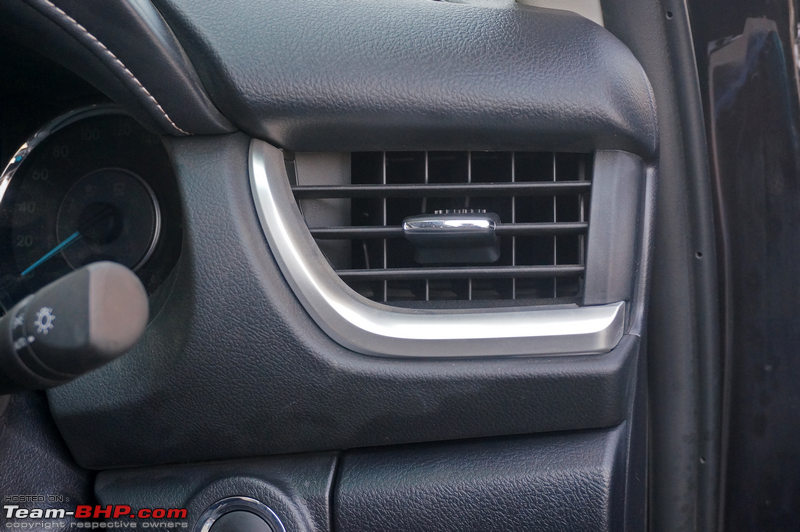 Small drawers on the driver + passenger side double up as cupholders. You can direct the airflow there to keep your Pepsi can cool! The plastic used is of basic quality though:  Parking sensor button and the controls for the tailgate opening mechanism to the right of the steering wheel. To open or close the tailgate, the ‘Power Door’ button has to be in "On" position and the button next to it needs to be kept pressed till the opening / closing action is completed. 3 blank fillers here are oddly scattered: 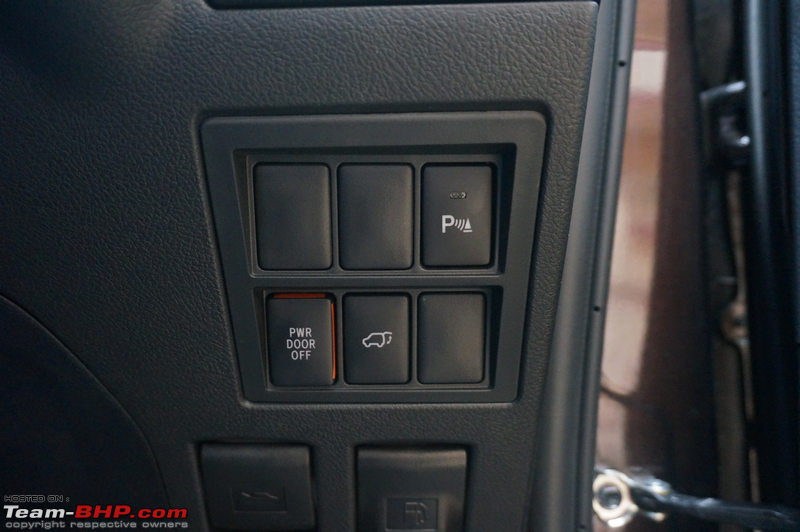 Flip-up levers for the bonnet & fuel lid:  Doors open in a triple-stage action. Doorpads have silver + leather inserts and house the front speakers + tweeters. Quality of materials used is acceptable:  Power window console has a piano black finish. All 4 windows get auto up & down. Buttons are illuminated too. Notice the recessed area on the driver’s button only. You do get electrically-foldable mirrors, but they don't auto-fold when you lock / unlock the car. I'm shocked that Toyota could miss a feature as important & as simple to activate!!  Leather insert with a silver highlight on the doorpad:  Sturdy chrome door handle. Driver's door can be unlocked by just pulling the inside door handle. Other doors need to be unlocked first, before the handle will open the door. Locking & unlocking sound is loud: 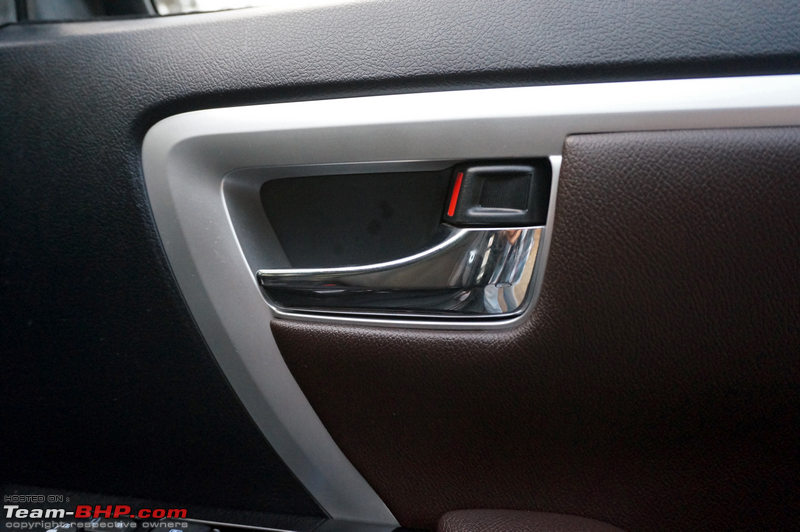 Armrest is draped in leather as well. It is soft and placed at a comfortable height:  Thin door pockets can hold a 1-liter bottle and some odd items. Should have been wider:  Puddle / warning lamps on all four doors; that's in addition to the puddle lamps under the ORVMs:  Running board is very wide. Ordinary-looking Toyota branded scuff plate is standard on all variants:  Front seats are firm & wide. They offer good support, but the dark brown leather upholstery is hard and plasticky. The adjustable headrests are firm as well. Toyota says these are whiplash-injury-lessening seats (more information):  8-way electric adjustment. Nothing for lumbar support though. At this price, Toyota?  On the downside, the seat doesn’t slide as far back as 6+ footers would prefer. Toyota must have restricted this to show rear seat legroom. When the seat height was cranked up to a medium level, it didn't slide as much behind as I'd prefer. Only solution was to lower the seat as it moves back & front with changes in the height adjustment. Even in the front passenger's seat, a 6 footer won't be able to completely stretch his legs:  Height adjustment has a healthy range - you can go from really low seating to a tall UV-like position. Not only can you raise the height, you can also tilt the seatbase for enhanced under-thigh support:  A closer look at the leather upholstery and its white stitching:  Manual adjustment for the front passenger seat. It lacks height adjustment as well:  Fabric skirts on the side of the front seats to cover up the ugly stuff (rails & mechanism):  Driver armrest is weirdly shaped to allow operation of the handbrake. It is clad in leather and the surface is soft. However, it’s not adjustable and shorter drivers may not find it to be conveniently placed:  Seatbelts are adjustable for height. They get pretensioners & load limiters:  The footwell is wide enough and the dead pedal is huge! Dead pedal is positioned perfectly and might even accommodate size 14 shoes! Not every day that we see such a long & wide dead pedal:  Sturdy grab handles on the A-pillars are useful when climbing in:  ORVM design is more carlike compared to the truck’ish units of the old car. Nevertheless, they are wide and offer an excellent view of the happenings behind. Additionally, the range of adjustment is wide enough to support short as well as tall drivers: 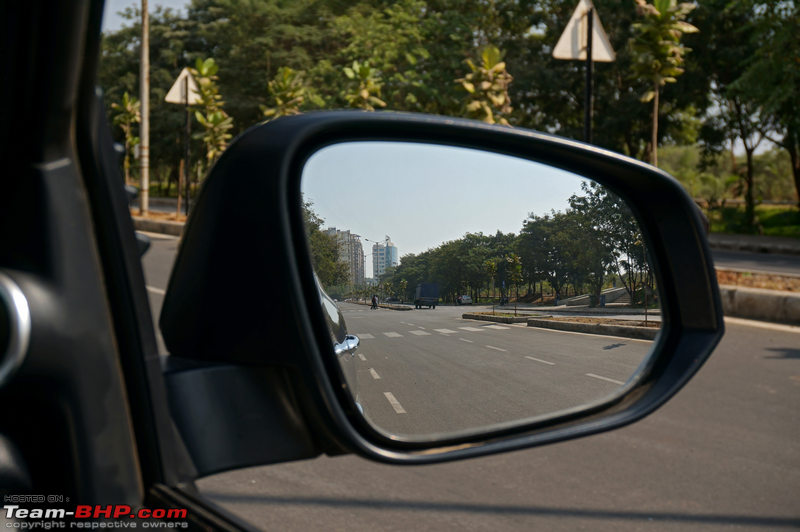 IRVM is wide, but thick D-pillars and large headrests limit rearward visibility. Can’t complain as it’s the same with all big SUVs. What we will complain about is that the IRVM is NOT auto-dimming….shocker!!  Rearward view is average. Thick C & D-pillars and passenger headrests mean you’ll be depending on that reversing camera more than you should. Watch out for bikes & low-slung cars parked close behind you:  Center fascia has leather and silver inserts on the sides. Piano black finish around the air-con vents, ICE and climate control system too:  A closer look at the leather insert on the side of the center fascia. The material is soft to touch, yet doesn’t feel particularly rich:  Rectangular air vents + digital clock sit on top of the center fascia. Air flow volume can be adjusted or turned off, if you so wish:  All variants get a touchscreen infotainment system. It's covered in detail in a separate post:  Quite silly that the yellow 'passenger airbag on' light is permanently activated. Instead, only the 'airbag off' light should come on (whenever it's deactivated): 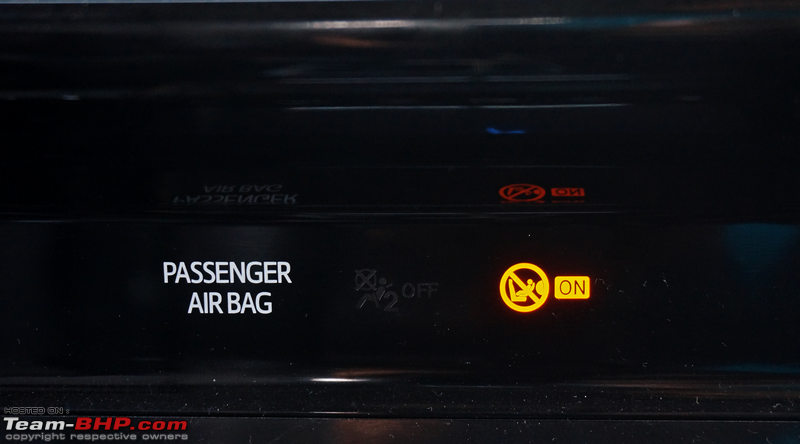 Climate control system performs well even on hot days. The temperature is adjusted by turning the rotary knob on the right, while fan speed is adjusted via the knob on the left. These knobs are hard and have a stiff action. The blower has 7 levels of adjustment. In levels 1 and 2, it is silent. At levels 3 and 4, it gets audible. At levels 5 and 6, it is loud, while on level 7, it creates a racket. The lowest temperate that the system goes to is 18 degrees centigrade before hitting LO; increments are in 0.5 degree levels. The rear air-con button is neatly integrated onto the blower knob. Rear passengers aren't dependent on those at the front though; they can start their air-con independently from the back. By default, the climate control starts in recirculation mode:  Below the climate control system are the 12V power & USB sockets, and controls for the TC, Downhill Assist Control and 4x4 system. The new Fortuner has a selectable 4WD system instead of the permanent unit of the older car:  2WD variants get a small storage cubicle instead of the 4WD control knob:  Shallow storage space at the base of the center fascia; you can slide your smartphone in here. It has a rubber lining on the surface for protection:  Bird's eye view of the center console:  Center console gets a pair of cupholders. Their lid has a wooden finish:  Handbrake is leather-wrapped with contrast stitching & a leather boot. Be sure to put the handbrake fully down; it tends to stay up a notch or two. There are short + fast warning beeps to indicate the same:  Next to the handbrake are buttons to activate the 'Eco' & 'Power' driving modes. If you've selected ECO, the setting is retained after restarting the car (not the case with PWR): 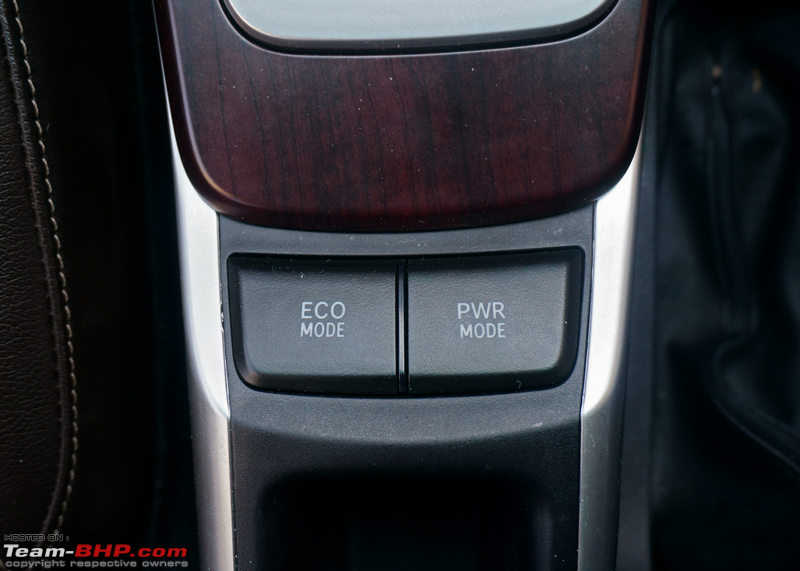 Small storage spot has been provided right behind: 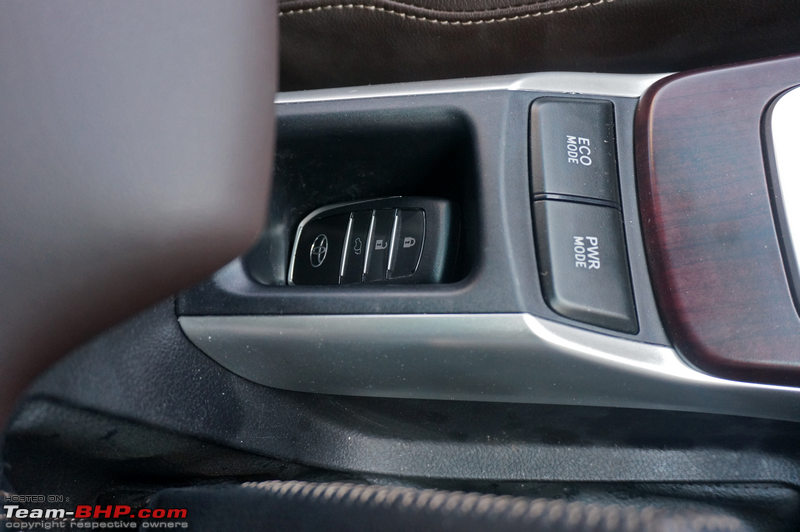 Under the driver's armrest is a fairly accommodating storage box with a carpeted base:  Fortuner has two gloveboxes. The upper unit gets a leather-wrapped lid:  Press the Fortuner-engraved button to open the upper glovebox:  It opens with a damped action. The glovebox is wide but shallow, hence suitable for coke cans, documents & miscellaneous items only:  Cooling functionality for your cans. Has 3 settings - off, intermediate & high:  Lower glovebox opens with a damped action as well. It’s more accommodating, albeit still about the size you see in C2-segment sedans. A big SUV should offer a larger glovebox IMHO. This one is illuminated and lockable. You can lock the glovebox and take the skeleton key with you, leaving the main smartkey with the driver / valet. Both gloveboxes close with a rattly sound:  Fit and finish here could have been better. Coloured wires behind the glovebox are easily visible to anyone in the passenger seat:  Sunvisors are draped in soft cloth, which has a velvet-like feel. Very sweet. Driver's side unit has instructions for operating the 4x4 system:  Both sunvisors get ticket holders and vanity mirrors with lights. Slide open the mirror and the light comes on automatically: 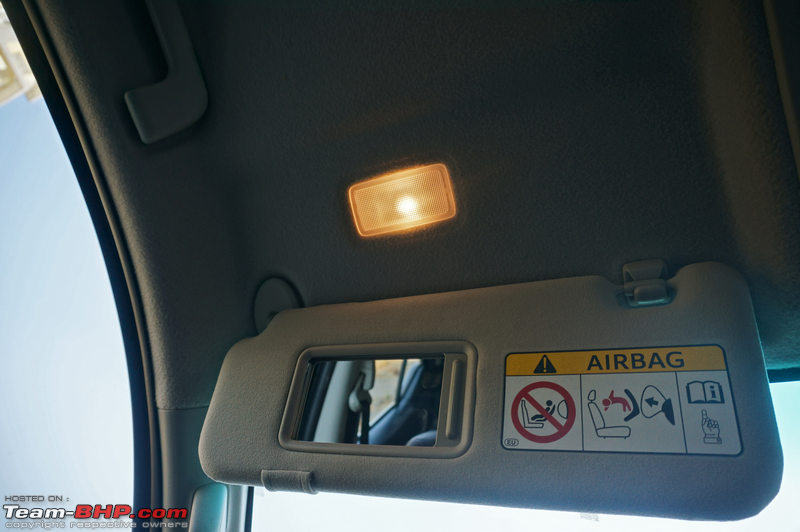 Cabin lights are bright white LEDs. They go out with a theatre-dimming effect upon locking the car: 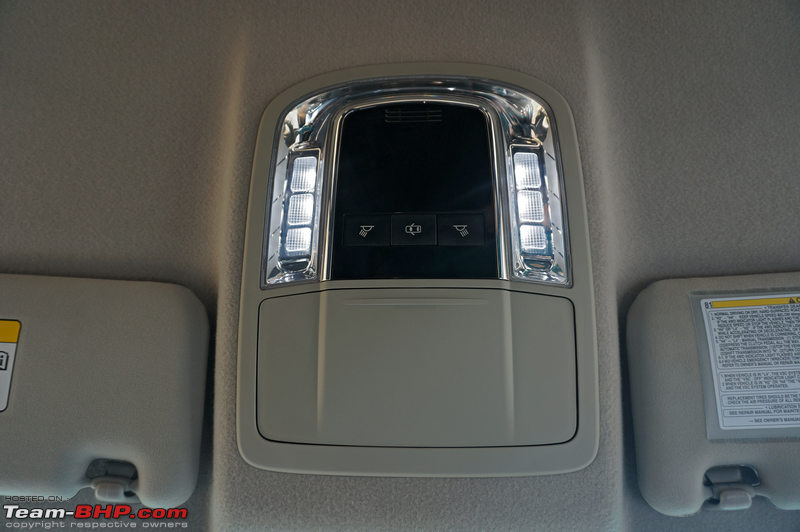 Notice how the middle button doesn’t sit flush with the ones on the sides, so that you can select the correct one easily (without looking). This panel also has a shiny black finish:  Sunglass holder is built of light plastic. Feels cheap. This black lining is only on the side visible here, but not on the bottom area. Partial lining could mean some scratches on your sunglasses. Should have had full lining inside:  Fortuner gets a total of 7 airbags (including one for the driver’s knee), just like the Innova Crysta:  Disable the front passenger's airbag from the side of the dashboard. You shouldn’t though – children should always be placed on the rear seat:  Where the driver's knee airbag is located. While I applaud Toyota for this, I have a feeling the decision has something to do with the Euro NCAP performing random tests on Indian cars. Thus, I'll give credit to both of them (Toyota & the Euro NCAP):  On the side of the seat...  ...and pillars:  Company recommended tyre pressures are 1 psi lower than the outgoing model's. Is this to soften the ride quality a bit?  Last edited by GTO : 29th January 2017 at 10:16. |
| |  (42)
Thanks (42)
Thanks
 |
| The following 42 BHPians Thank Aditya for this useful post: | ach1lles, Akshay1234, akshay81, anukritbhargava, AutoIndian, Avikbrio, CarguyNish, darklord, ecosport rules, espraveen, GTO, GTp0wer, InControl, IronH4WK, Jaggu, JoseVijay, JTM, Leoshashi, libranof1987, maddyguage, mroptimist, MSAneesh, NiInJa, Nohonking, noopster, parsh, phoenixash, Prakritij, ragh_bhushan, rakesht_ripps, RavenAvi, roby_dk, Roy.S, Rshreyansh, S.MJet, scopriobharath, Sheel, uday.ere, vb-saan, Vid6639, vishy76, vredesbyrd |
| | #5 |
| Team-BHP Support  | Interior - Rear The rear doors open in a double-stage action. While they open sufficiently wide, the height of the SUV makes ingress difficult. The seat is placed rather low as well, meaning you climb up and then sit down on it. Again, this isn’t a senior citizen-friendly ride:  Gap between the B-pillar and seat is adequate to move your feet in or out: 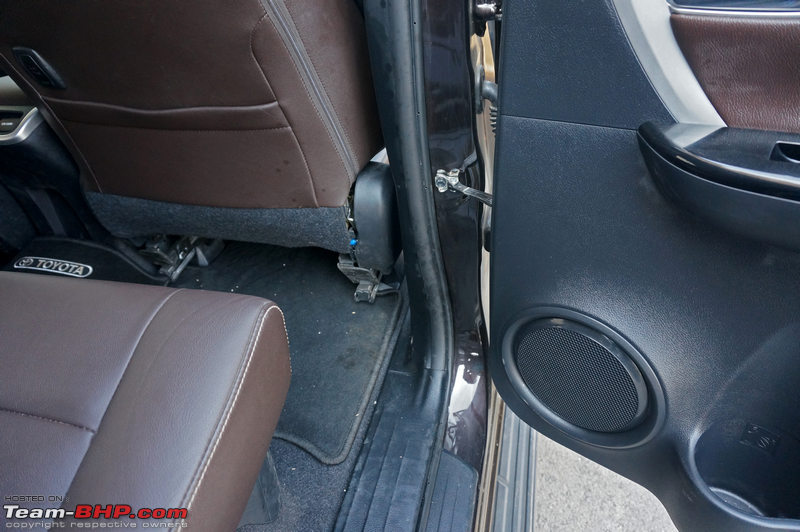 Door sill is wide, further hampering ingress & egress (more movement for your legs). Simple plastic scuff plate with no branding – so boring! Side step is very useful in this tall SUV:  Groove on the B-pillar to help with ingress. You can get a grip here before climbing in:  Like the front, the rear doors feel lighter than you’d expect in a 2 ton SUV. Doorpads get the same theme as the ones in the front (leather, silver and piano black inserts). Rear speakers are housed on them:  Small "Fortuner" branded insert on the window kink:  Like the front, the rear power window console has a piano black finish & auto up / down functionality:  Rear doorpads can hold a 1 liter bottle (tricky to pull the bottle out when the door is closed). While the door pockets are wider than the ones we saw at the front, their carrying capacity is still limited to small items only:  The Fortuner is only available in a 7-seater configuration (sadly, no captain seats like the Innova). The middle row is a 60:40 splitting bench seat. It’s large enough to accommodate 3 adults. While the seatbase is largely flat, the seatbacks have some contours to hold you in place. Leather upholstery is identical to the front seats and its cushioning is adequate:  The wheelbase is the same as the outgoing Fortuner and hence, space is more or less the same. Legroom is good. I could sit here, even with the front seat pushed all the way behind. Healthy foot room as well. Plus, the area where your foot would meet the front seat is soft:  I'm 5'10" and with the front seat in my driving position, I have about 3.5 inches of spare legroom:  The bench gets 3 headrests - all are softer than the ones at the front. All 3 occupants get 3-point seatbelts  . Center passenger will have to contend with rock hard plastic on his lower back though. Look closely and you'll see the two plastic covers (black) of the seat folding mechanism: . Center passenger will have to contend with rock hard plastic on his lower back though. Look closely and you'll see the two plastic covers (black) of the seat folding mechanism: Seats have sturdy metal adjustment levers (for fore & aft movement):  The travel range is limited though, and the difference between the two seats in extreme positions is ~3 inches only:  Low seat + high floor means taller passengers will find under-thigh support to be incomplete (those of regular height should be okay). That said, there is enough space under the front seats to slide your feet, so you can stretch your legs and get better under-thigh support. Headroom is just about adequate, although super tall dudes will be cutting it thin. They could also hit their head against the roof while offroading:  Both seats can be reclined or folded forward individually. You can set it up to a totally relaxed angle if you so wish:  Selective folding if you need to carry a combination of cargo + passengers:  When not in use, the seatbelt buckles & lap belt can be tucked away into cutouts:  Smart! One lever with two holding positions. The lower handle can be used by 2nd row occupants to adjust their backrest angle. The upper one will be used by 3rd row occupants to flip the seat forward (when they want to get out):  Middle passenger has his seatbelt mounted on the roof:  Even the buckle for the center passenger is marked such. No confusion: 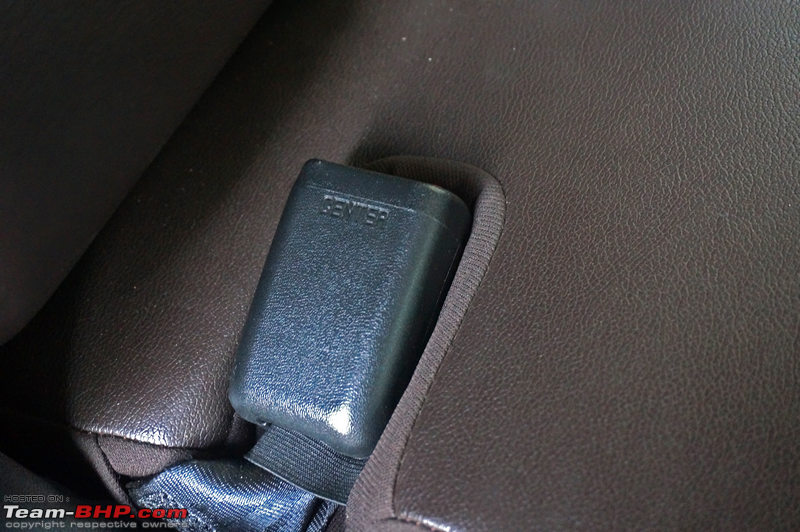 To unfasten, it needs to be pressed with the seatbelt clip (as shown):  Center passenger sits a little higher up due to the elevated seatbase; he also sits a little more in the front because of the protruding center armrest. Lastly, the headroom here will be even lesser than the sides (difference is evident in this pic):  Both seats have child-seat hooks: 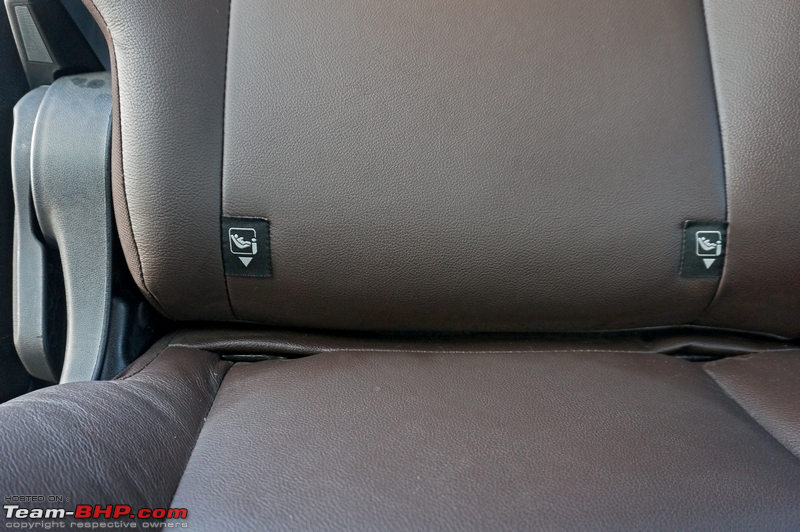 Center armrest is connected to the LHS seat. While it is positioned at a comfortable height, when you recline or slide the seat forward / backward, the armrest will (obviously) move with it. The cushioning is sufficient:  Pair of flip-out spring-loaded cupholders are housed in the center armrest:  Placed above the middle row is the light console (white LED) with rear air-con controls. All interior lights go out with a theatre dimming effect:  Just like we saw at the front, the ‘door open’ light button sits elevated so that you can choose the right button without looking: 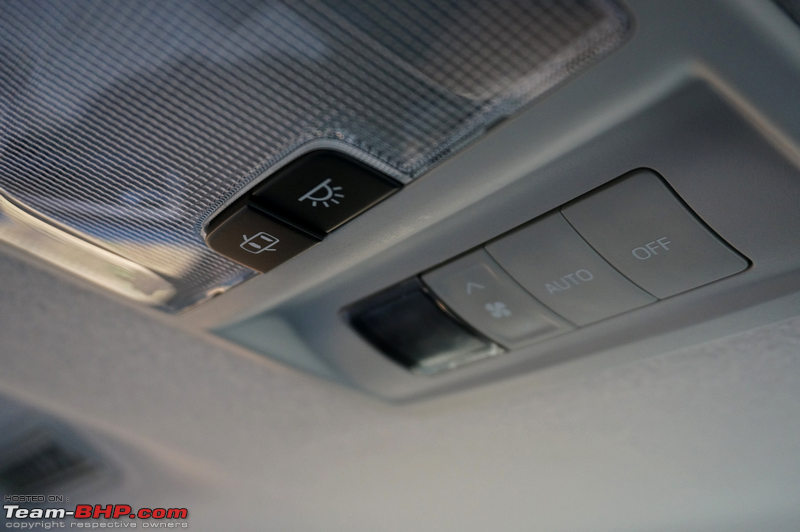 Rear air-con can be operated independently (no need to press the 'rear a/c' button on the dashboard). I must mention that the rear a/c can only cool the cabin. Heating is exclusively from the front air vents. Uniquely, the rear a/c gets an 'auto' button which will keep changing / optimising the blower speed! Cool. If you operate it manually, the blower offers 7 steps of adjustment. Until level 4, blower sound is perfectly under control. On level 5, it's audible. At 6 & 7 however, things get loud, but the noise isn't from these air vents; it's from somewhere behind!! We went looking for it. Turns out, the rear air-con's AHU unit is placed to the right of the 3rd row seat (behind the side panel). Now, the air-con blows cool (not cold) air in the 3rd row's RHS cupholder. Crank the blower level up and it sounds like a mini turbulence going on in the cupholder area!!  The roof-mounted air-con vents. To shut these vents, move the air flow direction controllers to the extreme right. However, even in the shut position, they let out a little air: 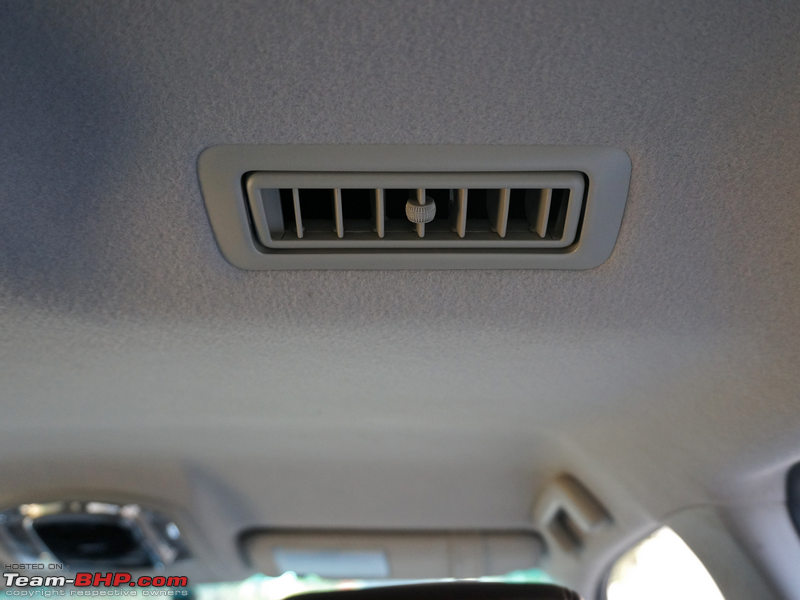 Both spring-loaded grab handles of the middle row get bag / coat hooks. These grab handles fold back in slowly. Are provided for everyone, including the driver (which is rare) & 3rd-row occupants:  Second row seatbelts are soft and placed at the perfect height:  Side airbags protect middle row passengers too:  Window rolls all the way in. Belt line is low enough here, thus lending a great view of the world outside. Despite the dark interiors, the cabin isn't claustrophobic at all:  Two seatback pockets. Not deep, but adequately wide. The inside of the seatback pockets has a nice smooth lining, so whatever you park here won't get scratched:  Seatback gets foldable bag hooks. Can hold upto 4 kg. Nifty:  Middle row passengers get a smartphone holder…  …and 12V power outlet, but no USB socket has been provided:  Floor hump is about 3 inches high, and it is wide. Coupled with the low seat, this means the center passenger will be more comfortable placing his feet on either side of the hump:  Last edited by GTO : 25th January 2017 at 15:49. |
| |  (33)
Thanks (33)
Thanks
 |
| The following 33 BHPians Thank Aditya for this useful post: | akshay81, AutoIndian, avinash_clt, CarguyNish, Contrapunto, ecosport rules, espraveen, GTO, InControl, IronH4WK, Jaggu, JoseVijay, JTM, Leoshashi, libranof1987, mroptimist, MSAneesh, Nohonking, noopster, parsh, phoenixash, Prakritij, ragh_bhushan, RavenAvi, sahibrain, scopriobharath, Sheel, SnS_12, T2luvroads, uday.ere, vb-saan, Vid6639, vredesbyrd |
| | #6 |
| Team-BHP Support  | Interior - 3rd Row You can flip the seat forward in a single, continuous motion. The flip & tumble operation is so intuitive to use that even a layman could pull it off, without asking for instructions. Toyota calls this 'one-touch access'. You have to fold & push the seat forward together. If you don't push, only the backrest will fold down (without the seat tumbling forward). As mentioned in the previous post, the seat's recline handle has two catches on it; 3rd row occupants can use the upper one without assistance to get out themselves. While this one touch tumble makes it easy to fold the seat, and the gap to get in is sufficient, ingress & egress are definitely not a job for the elderly / overweight. You still need to climb & crouch to get in. Be kind to the unfit and offer them the middle row seat:  How's the third row? It has room for 2 passengers and is usable for children / shorter adults. If 2nd row passengers are in a good mood, they can take their seats ahead, thereby liberating some legroom here. I could sit on the last row, but only because of the adjustable backrest. In full up position, you'll feel like you're in a cargo train. You need to recline the backrest down; it has many steps of adjustment and all the way down is how most people are going to prefer it. For reclining, a nice li'l handle is located within easy reach, right beside you (you don't have to go hunting for it). On the flipside, a trunk full of luggage might restrict how much you can recline the backrest. The seat is placed higher than the second row, but even the floor is higher, so for someone who is 5'10", under-thigh support is inexistent. I was sitting with my knees pointing upward. If the 2nd row is pushed ahead, shorter folk could extend their legs and increase under-thigh support a bit. The seatbacks of the 2nd row seats are not hard, thus you can bury your knees into them if necessary. Even the area where your shin and feet touch the seat ahead is soft. Overall, tall adults will be able to sit here for trips / movies / marriages within the city. On a Bombay to Goa run, the 3rd row should be left to children or short - medium sized adults. When it comes to the 3rd row seats, the Tata Hexa is better:  You can adjust the backrest angle, as shown in the picture:  Small, but conveniently placed plastic lever for reclining or folding the seat:  Unlike the Innova Crysta (in which Toyota insists that you can fit 3 passengers), this 3rd row is rated for 2 passengers only:  3rd row comfort depends on the mood of 2nd row passengers. Under-thigh support is inexistent:  Headroom is limited & definitely lesser than in the outgoing car. In this pic, you can see that it's just about enough for a 5’10” dude. Headrests have two locking positions; all the way down or all the way up. They're well sized & soft, therefore a fair place to rest your head:  With the middle row seat pushed all the way ahead, I have about 2 inches of knee room, while with the seat pushed all the way behind, my knees touch the seatback. Additionally, there is no room under the second row seats for sliding your feet. Seatbacks of the middle row seats are soft, unlike those of the Tata Hexa:  Just like the front and middle row vents, even those at the rear can be individually shut. However, a fair amount of air slips through anyway:  3rd row window is smaller than the old Fortuner's. Yet, it offers a decent view of the happenings outside:  Spring-loaded grab handles for last row occupants:  Left passenger gets a cup / bottle holder & phone platform. Hard plastic panel below it can be used by the LHS passenger to rest his arm on:  The one on the right gets room for two bottles. See those vents in the cupholder? If the blower level is at 5, they churn out cool (not cold) air. Will keep your bottle cool, but can get noisy as there's a mini-turbulence inside:  Two 3-point seatbelts:  A terrible idea to house the seatbelt on the seat itself (cars usually have it hanging next to the seat). With the current placement, an overweight person will 'sit on' the buckle, making it difficult to fasten the seatbelt. It'll be even trickier to unlock it! In a conventional placement where the buckle is hosted separately, you get a bit more wiggle room too:  Roof liner is durable, but not luxurious. Third roof-mounted cabin lamp illuminates the last row and also serves as the boot lamp. Ambient mood lighting from the Innova Crysta has been left out:  Even with the third row seats in place, there is space left over for a couple of medium-sized bags:  Backpack placed so you get a perspective of the boot size:  Third cabin light is located on top of the last row backrests. It is the only yellow light in the cabin - should have been white LEDs like the other units. When the boot is opened, all three cabin lamps come on if they are set in the "door open" position:  Notice the clean way in which you can park unused seatbelts. Even the seatbelt's clip has a dedicated holder. Having them slotted like this means no clanking / rattling noises from loose seatbelts:  Useful bag hooks have been provided on both sides of the boot: 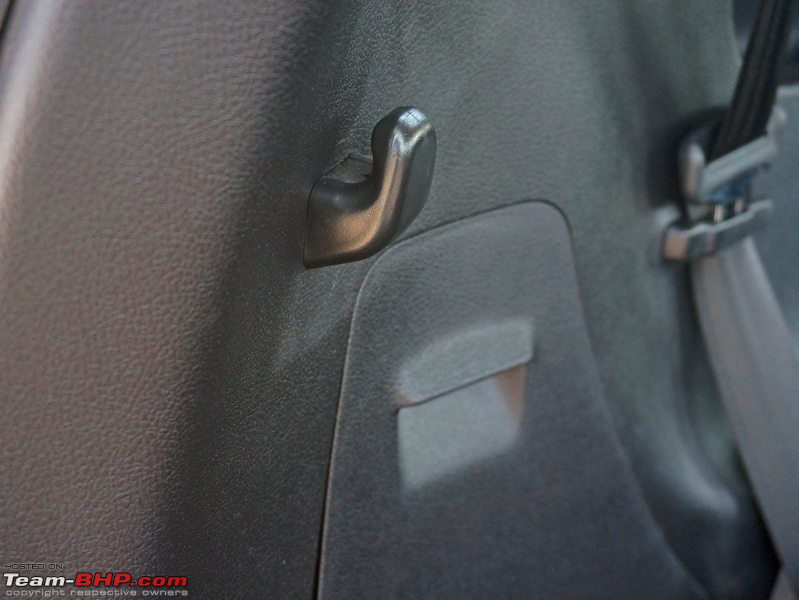 Removable plastic cover on the LHS:  Toolkit has been neatly arranged behind. The black rubber band holding it tight is of superb quality:  Toolkit consists of a bottle jack, a safety triangle and a high quality pouch…  …containing the regular tyre changing equipment, a spanner and a screwdriver:  12v power outlet located on the left. 3rd row passengers can use this socket to charge their smartphones:  Behind this plastic panel is the rear a/c AHU (a blower and second small evaporator core). Place your hand on it and you'll find it to be cool:  Back to carrying luggage, if you need more space, fold the 3rd row down:  To move it entirely out of the way, pull on this strap and lift the seat to the side (side-folding seats are so yesterday!). The mechanism does provide assistance when you are lifting it and the action is very light. Not a match to the Ford though; the cheaper Endeavour is available with electrically foldable seats that fold flat into the floor:  Fortuner gets a dedicated hook to lock the folded seat, and a velcro strap to tighten it. A rubber bush on the 3rd row seatback prevents it from rattling when folded away like this:  Cargo capacity is greatly increased with the 3rd row out of the way:  Not a flat floor. It dips around the 2nd seat row area:  If you want to haul more cargo, you can tumble the middle row seats forward:  Lock the middle-row seats in position by hooking these straps onto the legs of the front neck restraints (click to see how):  They have a pocket underneath in which you can tuck the latch & straps when not in use:  Tailgate gets full black cover on the inside. No ugly bits sticking out anywhere:  Powered tailgate is opened by simply long-pressing the electromagnetic release or the button on the keyfob. However, one must remember to unlock the car before trying this. If the car is locked, two beeps will be heard, but the tailgate won't open. Held up by two sturdy pneumatic struts. Tailgate has a memory function whereby you can set how far it should open up:  Simply press this button and the tailgate will electrically close = no human effort: 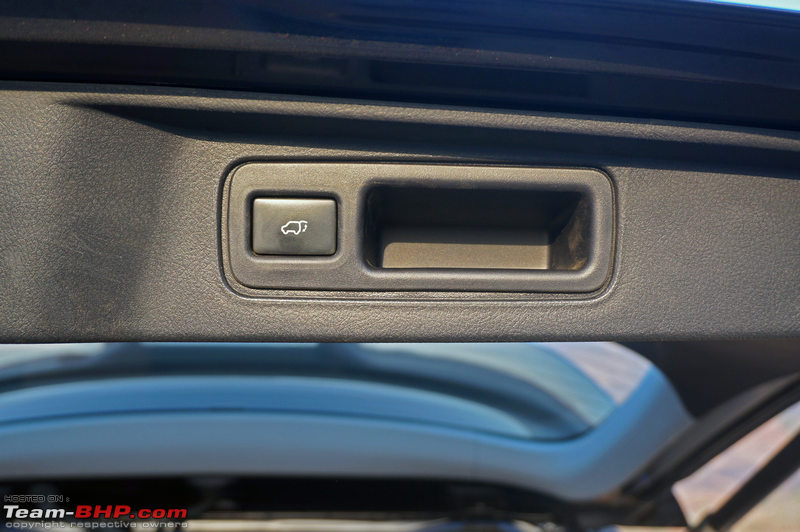 Spare wheel removal procedure is identical to the Innova's. Click here to see how:  Last edited by GTO : 25th January 2017 at 15:48. |
| |  (40)
Thanks (40)
Thanks
 |
| The following 40 BHPians Thank Aditya for this useful post: | Akshay1234, akshay81, AutoIndian, Avikbrio, CarguyNish, darklord, DrANTO, ecosport rules, GTO, GTp0wer, InControl, IronH4WK, Jaggu, JoseVijay, JTM, Leoshashi, libranof1987, mroptimist, MSAneesh, Mustang Sammy, Nohonking, noopster, parsh, phoenixash, Prakritij, ragh_bhushan, raptor_diwan, RavenAvi, roby_dk, Rshreyansh, S.MJet, scopriobharath, Sheel, T2luvroads, Turbanator, uday.ere, vb-saan, Vid6639, vredesbyrd, Yeldo |
| | #7 |
| Team-BHP Support  | In-Car Entertainment 7" capacitive touchscreen is very intuitive to use. All buttons & controls are big, making it easy to operate. Don't miss the 'reorder' button at the bottom; you can change the order of these menu items based on what you most frequently use. Touchscreen has 'flick & drag' which means you can use it just like a smartphone (to scroll through menus, for instance). Touch sensitivity is good, but there is a noticeable lag before the desired action is executed after you touch the screen. Should have had a cap over the ICE screen; under direct sunlight, there are visibility issues with the display. In terms of bass, even with the equaliser in neutral settings, there is noticeable bass. Big bass feels like it's coming more from the front of the cabin than anywhere else. The mids are weak and even if you pump them up in the equaliser, the sound doesn't have fullness to it. Most people will listen to music with the volume level in the 30s or 40s. The volume level goes up to a maximum of 63 without any distortion and it does pack a punch at the top. Though the overall sound quality is okay, it's not in the league of German cars or Tata's Harman sound systems:  USB and Aux-in ports are located lower on the center fascia. They have a rubber cover to prevent dust from entering:  Music is played out through 6 speakers (including 2 front tweeters):  Tweeters are placed prominently on the door. That gives it a really good sound stage for the high pitched frequencies. In some songs, the high notes hit you right in the face:  The usual set of inputs (DVD too), but dismally, no Android Auto or Apple CarPlay in this expensive truck. Ignore the USB 1 & 2 options. There is only 1 USB port in the Fortuner. This menu too can be reordered:  Play with these (basic) settings all you want, but audio quality remains average:  ICE shows you trip information, distance-to-empty and fuel-efficiency (average & real-time):  Graphical date-wise FE display!  Speed-sensitive volume feature has 3 adjustment levels:  Among the many options, you can also set the 'touch sensitivity' level:  Upload your own startup image:  Choose the colour theme (personal favourite is blue):  Super cool! You can customise the homescreen. Not only can you choose between it showing 2 panels or 3, you can also select exactly what is displayed in those boxes:  Sample display of a customised homescreen with 3 panels. To access your custom homescreen, simply press the bottom-right button marked ‘home’. Once your phone is paired up, you can save up to 50 voice tags for frequently used contacts. You can also choose from different ringtones on the ICE:  Navigation is good in terms of timing & accuracy. The instructions are spot on and easy to follow. Support for many Indian languages with male / female options. System can be slow to find the destination sometimes. It takes a while to zero in on the destination & pick the proper route:  Convenient! The MID also displays instructions. The MID goes back to the regular screen (e.g. eco meter) once you've followed the current instruction:  Stuff nearby:  Lack of attention to detail...unexpected from Toyota! Hyundai's navigation lists all the Hyundai workshops close by (link to image). No such option in the Fortuner's ICE:  Recording can be useful in unknown territory. You can store the route taken and then, retrace if needed:  "Where am I?" function shows your exact location – latitude, longitude & altitude:  A list of available satellites is also displayed:  While the standard disclaimer comes up at the start, you don't need to compulsorily press 'continue' to use the navigation (I find that very annoying). This screen will disappear shortly after:  SD card-based navigation:  Navigation software provided by iGO! The Innova Crysta we tested had MapMyIndia:  Sit back and enjoy a slideshow of pictures or play videos (DVD & USB stick)!  The blue line marks your car's path and it is accurate. You will need that in such a long vehicle. However, adaptive guidelines are not provided (at this price, Toyota??!!) and under bright sunlight, you have to strain your eyes a bit to read this display. Camera display is too ordinary - it's not fitting of such an expensive ride. You'll get audio feedback from the parking sensors as well. On the flip side, because both parking sensors are placed toward the bumper's center (no sensors on the side), be cautious about objects at the corners of the vehicle. Worse still, there are no 'front' parking sensors in his huge SUV. Owners will badly miss them:  You can tweak the camera's brightness & contrast levels:  Lists include favourites, call history and contacts. Transferring the call from the system to the phone (for privacy) and vice versa is not as quick as some of the other systems I've used. Phone clarity is good:  If the ignition is in ‘accessory mode’ (even if you’re playing music), after a while, the car switches off completely to save the battery:  ICE remote control feels like a cheap Chinese product (the type you get with unknown brand TVs):  Last edited by GTO : 25th January 2017 at 15:47. |
| |  (35)
Thanks (35)
Thanks
 |
| The following 35 BHPians Thank Aditya for this useful post: | Akshay1234, akshay81, AutoIndian, Avikbrio, CarguyNish, ecosport rules, GTO, InControl, IronH4WK, Jaggu, JoseVijay, Leoshashi, libranof1987, mroptimist, MSAneesh, noopster, parsh, phoenixash, Prakritij, R2D2, ragh_bhushan, rakesht_ripps, RavenAvi, roby_dk, Rshreyansh, S.MJet, Sankar, scopriobharath, Sheel, SnS_12, Turbanator, uday.ere, vb-saan, Vid6639, vredesbyrd |
| | #8 |
| Team-BHP Support  | Driving the 2.8L Diesel AT 2.8L diesel is smaller than the outgoing 3.0L, yet puts out more power. 175 BHP & 450 Nm of torque (420 Nm in the MT):  The Fortuner gets the same 2.8L diesel that made its debut in the Innova Crysta AT. This motor uses a variable geometry turbocharger. Power ratings are 175 BHP (@ 3,400 rpm) and 450 Nm of peak torque starting at a low 1,600 rpm (held till 2,400 rpm). While this is 3 horses and 90 Nm up on the Innova, it must be remembered that the SUV weighs a hefty 320 kilos more. The Fortuner also gets the same 6-speed slushbox as the MPV. However, unlike the Innova, the SUV gets a pair of paddle shifters for the driver's convenience. This means that the Innova AT has a superior power-to-weight ratio (95 vs 82 for the SUV), although the Fortuner has a torque-to-weight advantage (210 vs 198 for the MPV). On the open road, the Innova is certainly going to hang with the Fortuner…that’s for sure! Most of the previous-gen Fortuners were sold with the 4x2 (only enthusiasts buy the 4x4) and its AT variant was very popular. The slushbox was one of the reasons why customers chose a Fortuner over the Innova. Since the AT is now available in the new Innova, it's going to cannibalise the Fortuner bigtime. Remember how we spoke about the Innova Crysta blurring the gap between ‘MPV’ & ‘SUV’? Drive them back to back and you’ll know what we are talking about. The proof is in the pudding. And it’s not just the Innova – the 2016 Fortuner 4x4 AT’s power to weight is shorter than the old Fortuner’s 4x4 AT variant (82 vs 84.5)! Again, it does maintain a lead in the torque-to-weight standings (210 vs 180). For the Innova, the new engines brought a quantum performance increase; that’s not so much the case with the Fortuner. In what is fast becoming a trend, and a very welcome one at that, Toyota has equipped the Fortuner with Economy & Power driving modes (over & above the 'normal' mode). This is a superb way of customising the engine / throttle behaviour for prevailing driving conditions. • Normal mode: If neither of the two (eco or power) modes is selected, the Fortuner's engine runs in normal mode. This is a balance between economy & power. • Eco mode: Press the ECO button on the center console and you'll immediately see the air-con blower's level drop down a notch. The climate control works less harder in ECO mode - it still cools the cabin sufficiently though. Power delivery is also lower, with the throttle response dulled a bit. That said, because both engines are big & powerful, ECO mode is very useable in the 2.7 petrol & 2.8 diesel, both. It doesn't feel sluggish at all and there is more than enough grunt on tap. On a lighter note, having ECO mode on a big 2.7 petrol / 2.8 diesel is in itself a contradiction  . . • Power mode: Engage PWR mode and you'll feel the throttle to be sharper. The engine is very, very responsive in this driving mode. Acceleration times also noticeably improve. Ironically, PWR mode actually increases the steering's assistance a wee bit, making it lighter. You won't notice this unless you pay attention, but the difference is there. It is unlike conventional sport / power modes that actually firm up the steering for high speed driving. Finally, yes, the air-con blower level comes back up (if you're switching from eco -> power). Switch off the engine in ECO mode and it'll restart in ECO itself. However, PWR mode isn't retained after a restart - you have to manually select it again. After spending some time with the Fortuner, the difference between normal, ECO and PWR modes was enough that I could guess which mode the car is in, without looking at the instrument cluster. They have distinct characteristics. PWR & ECO mode status on the MID. Notice the difference in the way they're presented:  The Fortuner Automatic doesn't use a fancy dual-clutch transmission. Instead, a simple old school torque-converter unit does the job. Knowing Toyota, it'll be very reliable too. The Fortuner AT isn't going to wow you with lightning fast shifts or super smart logic, yet it will take you from point A to B in extreme convenience. The AT doesn't leave much room for complaint, but it doesn't give you anything to write home about either. Press the brake pedal & hit the engine start button to fire her up. The AT's gear shifter is calm and composed. It remains that way on the move. However, on startup, the car suffers cabin shake. At idle, the big 2.8L diesel is audible on the outside, but shut the door & windows and the noise goes away. Cabin insulation is very good. Outside noise stays outside (note: engine noise is audible at higher revs). Thanks to the torque converter, the way the vehicle moves from a standstill is smooth & seamless. In bumper to bumper traffic, the transmission's creep makes the Fortuner crawl at 8-9 km/h (without accelerator input). You can drive with just your foot on the brake pedal through bottlenecks. Peak torque is developed early @ 1,600 rpm, thus there's very little lag to speak of in the AT. Even at low rpms, the throttle is responsive. With a light foot in the city, upshifts happen at as low as 1,500 rpm! This helps you cruise around with smooth shifts & low engine sound. The AT is keen to upshift and will quickly make its way up the ladder - at times, you'll see upshifts happening as soon as you take your foot off the accelerator (uncool for people like us who like engine braking). This is a big & powerful diesel, hence you don't need to give it heavy revs within the city. Soft inputs work best for normal commuting. However, press the accelerator halfway in and shift quality definitely becomes perceptible. While the gearbox is still overall smooth, it's not an absolutely seamless shifting experience above 2,000 rpm. You'll know when the shifts are taking place. The engine & gearbox are also very responsive to throttle input. Some owners might feel that they are in fact too responsive! Even in normal mode, the engine revvs with a slight tap on the pedal. This is why you'll see the 2.8L revving unnecessarily when shifting between the lower gears. Solution? Eco mode. On Team-BHP, we don't usually recommend driving around in ECO, yet for the city, we'll make an exception with the Fortuner AT. Because of the dulled throttle response, the driving experience is smoothest in ECO. This is the mode you have to use within the city and - as mentioned before - it's still quick enough. Power mode for your daily commute? Fellow passengers will find it too jerky as the throttle is damn sharp. Drive around town in ECO mode and the experience is calm. On the open road, the Fortuner AT is a fast SUV (although the Endeavour 3.2 is quicker). The engine remains responsive above 2,500 rpm. Because of its big engine and the power on tap, you'll never be left wanting for punch. Also, power mode does bring an enhanced sense of urgency to the engine (although normal & ECO are useable on the highway too). The Fortuner AT can be a lively intercity express. In kickdown, upshifts take place in the vicinity of 4,000 rpm. Don't drive it in a pedal to the metal style though. Rather, you should build up speed gradually, else you'll get a lot of noise as the engine revvs & the gearbox drops a gear (more on NVH later, but it makes quite a racket for a premium SUV). This 2.8L is not as revv-happy as the Endeavour 3.2 either. Best part about the car is its cruising ability. Thanks to the tall 6th gear, 100 kph comes in at merely ~1,500 rpm. At this point, engine noise is virtually absent. The Fortuner AT is a very calm long distance cruiser. Overtaking doesn't pose a problem at all. There's ample power and you have a great view of the road ahead. However, the 6-speed has that conventional AT lag (~1 second) between your putting the foot down and the gearbox downshifting. After that, she pulls away nicely. I did face one problem at high speeds here - due to conservative tuning and limited revs, at times if you jump out of the lane and want to overtake, the gearbox drops just one gear when you wish it had dropped two. The downshift logic isn't aggressive and you'll need to be patient in such a situation. Thus, on two-lane highways where you need to make quick moves, I'd recommend PWR mode. It'll give you more punch. Another option is to prepare the car for overtaking (via a downshift using the paddle shifters) before the actual move. Manual mode is engaged by either putting the gear shifter in S mode or by using the paddle shifters located behind the steering wheel. These paddle shifters are of good quality and very well placed, making them convenient to operate. The paddles feel better than the other car we drove on the same weekend (the Mustang!!!). However, at times, there is a noticeable lag with the paddle shifts – the actual gear change happens so late (1+ second) that you can’t really depend on them. The only time you should use manual mode is for overtaking and when you need the additional engine braking (say, going downhill). Other than that, I don't see anyone playing with the manual mode in a big, fat SUV. With manual mode, the 2.8L hits its max revvs of about 4,500 rpm. Nope, this isn't your modern diesel that revvs to 5,000 rpm and beyond. Further, manual mode is tuned conservatively. It won't allow aggressive downshifts where the resultant rpm would be too high, thus you can't entirely rely on it for engine braking when running down a ghat. In comparison, the Endeavour's AT was far more willing. The Fortuner's S-mode is very funny. Actually, it's not an S mode at all. Remember the D2 / D3 / D4 positions on older ATs which denote the max gear you are allowing it to shift up to? That's exactly what the Fortuner AT does in 'S' mode. As an example, move the lever to S and you'll see S4 on the instrument cluster chosen by default. This doesn't mean that the current gear is no.4. Rather, that's the topmost gear that the AT will drive in. It will remain between 1 - 4. You can similarly choose to restrict the AT to 3rd; drive at 4,500 rpm all day long and the box won't upshift. This is unlike proper 'S' modes which move up the shift points and give the gearbox a more aggressive nature. No such thing here, Sport mode doesn’t necessarily result in a lower gear for every situation. The problem is, the layman won't realise this. He'll select 'S' mode thinking it's quicker and see 120 kph at higher revvs in 4th (as S4 is chosen by default). Many people won't even know what they are supposed to do for easier cruising. Only an enthusiast will manually shift up to S5. Those looking for a real 'sport' mode can keep the gear lever in D, but select the engine's PWR mode. The real S isn't on the gear shifter...it's on the center console! In terms of NVH, at idle, the diesel is audible on the outside, but shut the doors & windows and the cabin is sufficiently insulated from that sound. At city rpms (2,000 rpm & under), engine noise is under control. Even above that, the 2.8L emanates more of a 'hum' rather than a 'clatter'. It's a typical big diesel hum that you won't see in smaller engines. Over 3,000 rpm however, the engine does get noisy. And it's not got a nice note. Where the Endeavour 3.2 sounds sweet, the Fortuner is too utilitarian. Take the revv needle to 4,000 rpm and the diesel gets awfully loud. Passengers will ask you to back off. The new Fortuner is quieter than the older car, but it’s still not got the refinement you’d expect in a 35 lakh SUV. Due to the 2,100+ kilo kerb weight, large engine size & AT, don't expect FE to be high. Depending on traffic conditions and how happy your right foot is, you can expect anywhere between 7 - 10 km/l (tops) in the city. On the highway, figures should be more respectable, thanks to the 6th gear & low cruising rpms. An ECO light comes on in the instrument cluster when the car is being driven economically. 6-speed AT. Black & brushed silver gear lever looks smart. Gated shifter means no 'unlock' button. While driving, you can freely move between R-N-D! "Shift Lock" is placed under the black plastic cap (above "P"). Use the shift lock when you park on an incline and can’t move the lever out of "P". The feature could also be used when towing the vehicle:  Tap up for an upshift & vice versa - just the way I love it! European cars follow the opposite pattern (i.e. tap up for downshift):  Engage the fake 'S' mode and you'll see 'S4' selected by default. This ain't no sport mode. Rather, it's the 'max permitted gear', beyond which the box won't upshift. You can of course change this limit. Bummer, the MID doesn't show you the current gear:  The 2.8L diesel on display at the Auto Expo: 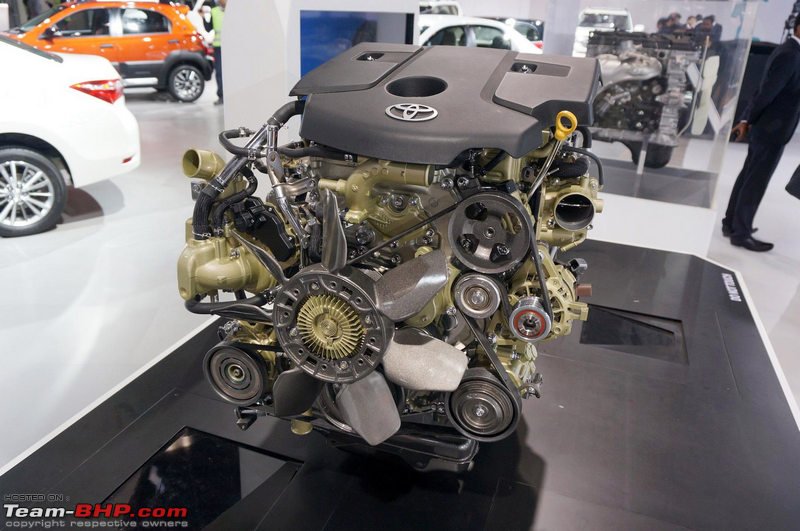 From the side: 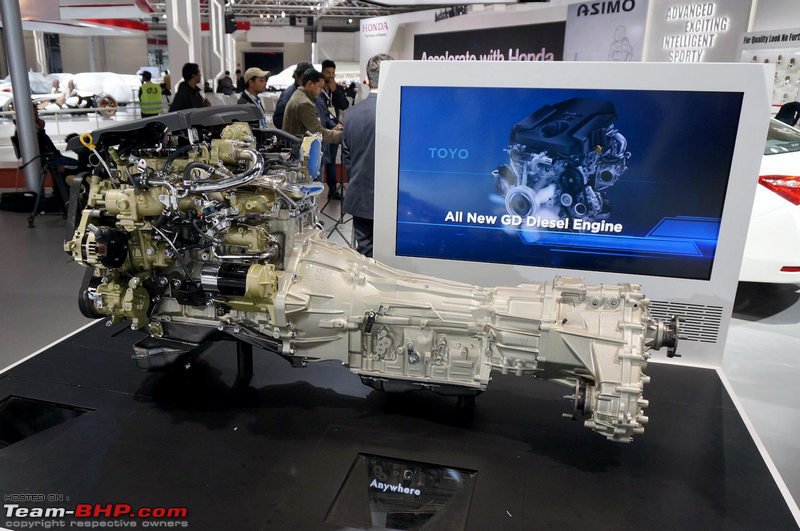 Both engines get an insulation sheet under the hood. What sucks is, there are no gas struts to lift that h-e-a-v-y bonnet up. No cost-cutting at this price, Toyota! You will need two strong hands to lift it up. If you are a short person, forget about it:  Large plastic panel covers the huge gap between the frame and front grille:  Intercooler is located below the plastic panel. No more on top of the engine, like the old Fortuner (reference image):  Air box now rectangular, compared to the earlier Fortuner's round one:  Partial firewall cladding on the left...  ...and full on the right:  Holy cow! Just look at the size of that headlamp! It stretches a long way back. We predict that, in the next-gen Fortuner, it’ll touch the A-pillar for sure:  Variable-geometry turbocharger mounted on the left:  Unlike the Innova Crysta (reference image), the brake fluid reservoir is more conveniently placed:  Underbody protection sheet does not extend all the way, which means you can see the road surface through the engine bay:  Specific instructions on refilling the coolant and dual air-con's refrigerant:  Last edited by GTO : 25th January 2017 at 18:09. |
| |  (38)
Thanks (38)
Thanks
 |
| The following 38 BHPians Thank Aditya for this useful post: | Akshay1234, akshay81, AutoIndian, Avikbrio, BlackPearl, CarguyNish, DrANTO, ecosport rules, Flyer, GTO, InControl, IronH4WK, Jaggu, JoseVijay, Leoshashi, libranof1987, mroptimist, MSAneesh, Mustang Sammy, Nohonking, noopster, parsh, phoenixash, Prakritij, R2D2, ragh_bhushan, rakesht_ripps, RavenAvi, Rshreyansh, sahibrain, scopriobharath, Sheel, SnS_12, T2luvroads, Turbanator, vaasu, vb-saan, Vid6639 |
| | #9 |
| Team-BHP Support  | Driving the 2.8L Diesel MT A big shoutout to BHPian Karan561 for letting us drive his brand new Fortuner MT. Thank you! The Fortuner 2.8L diesel is available with a 6-speed manual transmission, a combination that the Innova Crysta doesn’t get. The manual gearbox will appeal to those who like to drive in a more enthusiastic manner; it’ll also attract offroaders who desire the additional control that it provides in the rough. While the 2.8L MT has the same 175 BHP (@ 3,400 rpm) as the AT, its torque rating is a little lower at 420 Nm (AT = 450 NM). Why? We’re guessing it’s probably the max that the gearbox / clutch can handle. Weirdly, the MT is 5 kilos heavier than the AT (usually the other way around)! With a kerb weight of 2,145 kg, the MT has a power to weight ratio of 82 BHP / ton and a torque to weight ratio of 196 Nm / ton. Press the clutch pedal & hit the engine start button to fire her up. As the starter cranks, the gear lever moves violently, accompanied by noticeable cabin shake. While driving too, the gear lever continues to shake all the time. With accelerator input, it will move to the right, and return to its original position upon leaving the throttle. Yes, it does a dance when you switch off the engine too. Good news is, the shifter isn't truck-like anymore (although it isn't exactly car-like either). The throws are shorter now (albeit still on the longer side) and the gates are well-defined. Shift actions are light as well. I found the gearbox a pleasure to use. The only tricky part is ‘reverse’ which is located to the extreme left and up. In this position, the throw of the lever is quite far and shorter drivers will find it inconvenient. The action does require some effort. The clutch travels a long way, but it is light by big SUV standards - no one will have any complaints regarding its operation. The Fortuner MT feels sprightly in the city. Throttle response is very good and moving off from a standstill is effortless. Peak torque is made between 1,600 - 2,400 rpm and turbo lag is well controlled. The engine has a very tractable nature; you can even pull away from a standstill in second gear. You can drive around at 50 km/h in third gear with the engine turning over at 1,700 rpm. Depending on the traffic, you could use 3rd like an automatic. Gear changes aren’t required frequently in the city & driveability is overall good. Just as with the AT variant, the MT’s ECO mode is useable in urban traffic. The blunted throttle response ensures that the overall driving experience is smoother than in the other modes. If you need some more punch, engage normal mode which also allows for a smooth drive. On the other hand, PWR mode isn’t recommended for your daily commute to work. The throttle becomes so sharp that it makes things rather jerky. On the open road, the engine has enough power and torque to cruise all day long in the triple digits. In 6th gear at 100 km/h & 120 km/h, the engine is revving at 1,600 rpm & 1,900 rpm respectively. Eco and Normal modes can be used if you want to gradually build up speed or amble along the expressway. However, if you want to get a move on, it's best to engage PWR mode. You can have some real fun on the highway as the Fortuner can truly motor along at a good pace. The sharp throttle response helps you increase your speed with the slightest of accelerator inputs, and the excellent frontal visibility boosts confidence. What is not cool for long journeys is that the Fortuner MT gets a pathetic dead pedal compared to the AT. A proper resting pedal will be sorely missed on the highway. It is important to mention that 6th gear is best engaged above 80 km/h. Vibrations filter into the cabin if it is engaged earlier & the engine feels like it’s being lugged. The Fortuner MT's party piece is the iMT (Intelligent Manual Transmission) button. This segment-first feature is basically revv-matching. iMT automatically increases or decreases the engine revvs according to gearshifts, so that shifting remains a jerk-free experience. Shift a gear and before you release the clutch pedal, the matching revvs are ready for you. iMT works during upshifts as well as downshifts! It can be felt more while downshifting and surely brings a smile on the face. Even chauffeur-driven owners will appreciate the feature as it leads to a smoother overall drive experience. Noteworthy to mention that iMT is a diesel-only feature (petrol MT doesn't get it). The diesel MT is the most fuel efficient variant of the Fortuner. The ARAI has certified it at 14.24 km/l. MT has a clutch start system, meaning you have to press the clutch pedal before firing her up:  The pedals are well spaced out. Lots of room here. Unfortunately, a proper dead pedal is missing. Where the AT has a large & comfy piece, the MT gets a thin strip stuck to the floor. A sorry excuse of a dead pedal, I must say! When touring long distance, you can't rest your foot at a comfortable angle (like in the AT):  6-speed MT versus the earlier Fortuner’s 5-speed. Aesthetically, the MT's gear lever isn't truck-like anymore. However, it's always shaking & dancing. A turn-off in an otherwise decent cabin:  Styling wise, the gear lever is identical to the Innova Crysta's, with a chrome ring at the base, leather boot and white stitching:  The two cupholders we saw in the AT are missing in the MT:  Size of ECO and PWR buttons is smaller to accommodate the iMT button on the left:  iMT gets an indicator on the MID. Feature is automatically disengaged when the engine is turned off (you need to manually switch it on after a restart). No gearshift indicator provided:  Last edited by GTO : 25th January 2017 at 15:40. |
| |  (38)
Thanks (38)
Thanks
 |
| The following 38 BHPians Thank Aditya for this useful post: | akshay81, Aniket6, AutoIndian, Avikbrio, BlackPearl, CarguyNish, DrANTO, ecosport rules, espraveen, GTO, haisaikat, InControl, IronH4WK, Jaggu, JoseVijay, karan561, Leoshashi, libranof1987, mroptimist, MSAneesh, Mustang Sammy, Nohonking, noopster, parsh, phoenixash, Prakritij, ragh_bhushan, Rajeevraj, RavenAvi, Roy.S, Rshreyansh, Sankar, scopriobharath, Sheel, SnS_12, T2luvroads, vb-saan, Vid6639 |
| | #10 |
| Team-BHP Support  | Driving the 2.7L Petrol AT Big 2.7L petrol develops 164 BHP, but merely 245 Nm of torque:  The Fortuner also gets the 2.7L, 4-cylinder petrol engine that was first seen in the Innova Crysta. While not many customers are likely to opt for this motor, Toyota has introduced it as a precautionary measure just in case there is a diesel engine ban in the future. The last time around, Innovas & Fortuners were wiped clean from Delhi-NCR showrooms! This way, at least they will have some presence. Also, while the Fortuner diesel is the more impressive, the Fortuner petrol is a fair choice for a customer looking at refinement, a Rs. 2.5 lakh lower price (more like 3 lakhs on the road) and lesser daily running. Just note that the resale on big petrol SUVs is disastrous, as is their fuel economy. No modern direct-injection or turbo-charging techniques here. The petrol is an old-school naturally aspirated motor using a variable valve timing system. It produces 164 BHP (@ 5,200 rpm) and 245 Nm of peak torque (@ 4,000 rpm). These figures are identical to those of the Innova Crysta. However, with a hefty kerb weight of 1,900 kilos, the Fortuner's power to weight (86 BHP / ton) & torque to weight (129 Nm / ton) ratios are poorer than its sibling. Just like the MPV, the Fortuner petrol is available only in a RWD configuration. No 4x4 option. You can pick from a 5-speed MT or 6-speed AT (with paddle shifters). The AT is just like the diesel’s – it won’t wow you with lightning fast response times, but there’s not much to complain about either. It does the job. The petrol version is equipped with ECO & PWR driving modes too. How these modes work is explained in the Diesel AT post – please refer to that. The startup experience is so different from the diesel’s. In India, we are accustomed to firing up big SUVs and hearing their inherent clatter. Well, the Fortuner petrol is so refined that you won’t even be able to tell that the engine is running! Yes, there is some cabin shake & mild vibration on startup, but they’re far lesser than in the diesel. As I have mentioned earlier, cabin insulation is very good and outside noises do not make their way in. The SUV moves forward in a smooth, seamless manner. In bumper to bumper traffic, the transmission's creep makes the Fortuner crawl at 4-5 km/h (lower than the diesel). Throttle response is satisfactory and with a light foot, the transmission shifts up early (<2,000 rpm). Drive calmly and the AT will reward you with smooth shifts. Combine that with the silent nature of the engine and it makes for a calm urban commuter. On the other hand, if you start getting aggressive with the throttle, the gearshifts will become noticeable. There is enough power available for the city so, honestly, there’s no point in revving the petrol too much here. Once again, ECO mode is very useable in the city and makes for a smoother experience as throttle response is dulled. That said, the petrol engine lacks the torque of the diesel and when a gap to the car ahead needs to be closed quickly, you will want to move out of ECO mode. PWR mode is really not city-friendly though. The sharpened throttle response can make things jerky. We recommend using ‘normal’ mode for the city (in the diesel, we recommended ‘eco’). On the open road, the Fortuner petrol is an excellent cruiser, seeing 100 km/h at just 1,750 rpm. Passengers won’t even hear the engine! There is adequate power available through the rev range & the engine is pretty rev happy (by SUV standards). However, with almost 50% lesser torque than its diesel sibling, the petrol just doesn’t have that kind of punch on the highway. There are times when the torque comes up short and you’ll only hear a lot of noise…with little progress. This happens a lot in a pedal-to-the-metal driving style. It’s best that the smooth Fortuner is driven sedately on the highway, with the driver exploring the higher rev range only while overtaking. Once your overtaking move is completed, move back to cruising mode. This isn’t a road-burning SUV and neither is its gearbox a fast downshifter. Sit back & enjoy the refinement instead. We would recommend keeping PWR mode engaged on the highway as throttle & engine response are noticeably superior here. For regular overtaking, you can let the gearbox do all the work. But if it’s a tighter move, then the driver must downshift & bring the engine into its powerband before moving out of his lane. One good thing about the Fortuner is, if you give it a downshift command which the gearbox doesn’t agree with, the system gives out an audible beep. This is better than other cars which just silently ignore your command  . . You’ll also need to keep PWR mode engaged on hilly climbs or when carrying a full load of passengers. Primary reason = only 245 Nm of torque on tap (a cheap Ameo diesel offers more torque!). The gearbox is overworked when climbing up ghats as it continuously shifts up & down. The Fortuner petrol AT comes with an ARAI-certified fuel efficiency of 10.26 km/l (10.01 km/l for the MT). You can totally ignore that though. In a mix of urban + highway and sedate + aggressive driving, I managed a tear-inducing 6.5 km/l! Yep, she’s a guzzler. You’ll be filling that 80L fuel tank often. Engine fills up the bay, but the lack of a big cover makes it look cluttered / old-school:  16v, DOHC motor has variable valve timing. No direct-injection or turbo-charging techniques which would have helped improve the torque output:  Black & silver gear shifter is shared with its oil-burning sibling:  Last edited by GTO : 25th January 2017 at 15:37. |
| |  (37)
Thanks (37)
Thanks
 |
| The following 37 BHPians Thank Aditya for this useful post: | akshay81, AutoIndian, Avikbrio, CarguyNish, CEF_Beasts, chinmaypillay, Contrapunto, ecosport rules, foby.sebastian, GTO, haisaikat, InControl, IronH4WK, Jaggu, JoseVijay, Leoshashi, libranof1987, MSAneesh, Mustang Sammy, noopster, parsh, phoenixash, Prakritij, R2D2, rakesht_ripps, RavenAvi, Roy.S, Rshreyansh, Sankar, scopriobharath, Simat, SnS_12, theexperthand, Turbanator, vb-saan, Vid6639, vredesbyrd |
| | #11 |
| Team-BHP Support  | Ride & Handling The Fortuner comes with a double-wishbone front suspension and a 4-link solid-axle rear. Ride quality is decidedly better than the bumpy ol’ Fortuner and the newer car feels a lot more liveable. Owners won’t be complaining of excessive truck-like bumpiness anymore. That said, it’s still not what we’d call ‘plush’. On uneven tarmac, the Fortuner does feel jiggly, and even small bumps & undulations make themselves felt inside the cabin. It rides like a typical body-on-frame UV, and sharp bumps come in strong. Some of this is definitely down to the 18” rim size. While the suspension goes about its business silently, it will always let you know what kind of road you are travelling on (unlike say, the Hexa). As the speed increases, absorption levels get better. The suspension is set up on the firmer side and that helps its highway ride quality. She doesn’t bounce about on undulating roads, feeling more mature than the outgoing Fortuner. At speed, you won’t even be slowing down for broken roads. Still, highway comfort levels aren’t what we’d call great. For instance, joints on the expressway are transmitted inside the cabin. Overall, we’ll say that she’s compliant, but not luxurious. On the move, the Fortuner feels very sturdy. Straight line stability is very good and this Toyota stays composed at high speed. Crosswinds don't seem to affect it either. Take corners and you’ll see that body roll is better controlled vs the older Fortuner, although it is still very much there. You have to remember this is a tall body-on-frame vehicle and be conservative while tackling curves. It’s definitely no corner-carver like some monocoque SUVs and shouldn’t be thrown around on winding country roads. Be mindful of its height & weight. To their credit, the 265 mm tyres provide a healthy amount of grip. All variants of the Fortuner (apart from the 2WD MT) get ESP / VSC which can be a life-saver in an emergency manouveur. Newbies will also appreciate the ‘hill start assist’ feature which holds the car in place on inclines. It prevents rollback in stop & go traffic. The 4WD variants are further equipped with downhill assist control. The Fortuner’s steering is hydraulically assisted. While it doesn’t feel as heavy as the Innova's unit at parking or crawling speeds, it is not light either. This means parking the large SUV into a tight spot will require a good deal of effort; those who are used to modern EPS systems will inevitably complain. Once the speedometer needle climbs, the steering does feel easier to operate. It also offers sufficient weight on the highway. The 5.8 m turning radius is large, yet par for the course in a UV of this size. You will be making 3-point turns more often than not. Additionally, the steering takes ~3 1/4 turns from lock to lock. Piloting such large SUVs isn’t easy in narrow and crowded areas. After 6 years of our complaining, the Fortuner finally gets disc brakes all around. We’re happy to report that its braking is finally up to acceptable levels. We put her through hard-braking from 100 km/h too and she came to a standstill sans drama. Even then, one must remember that the Fortuner weighs over 2 tons and hence, it’s a good idea to maintain a big gap from the car in front. Yes, like most other SUVs, the Fortuner's nose dives under braking, but not excessively so. The Fortuner diesel is equipped with 'pitch & bounce' control (also seen in the Prius & Innova Crysta). Toyota says that the system ensures a smoother ride by using engine torque to suppress any pitching & bouncing motion caused by road conditions or driver input: 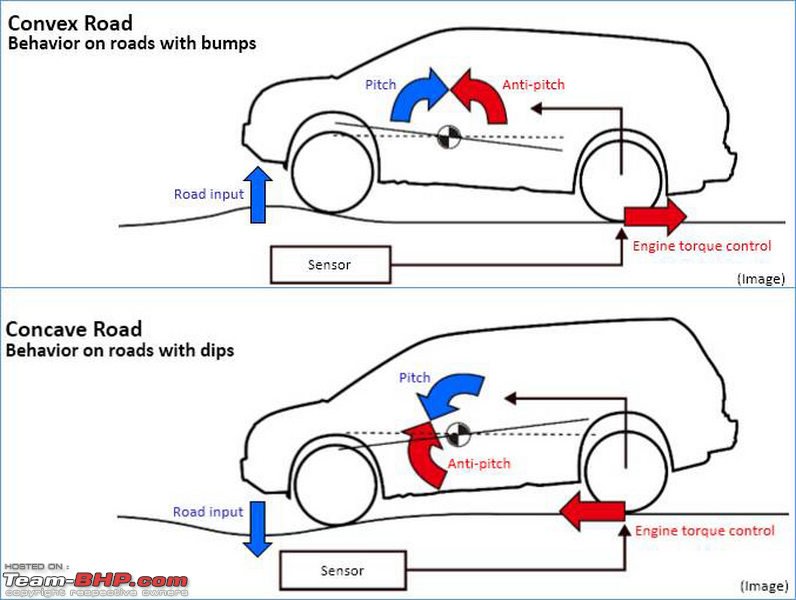 Last edited by GTO : 26th January 2017 at 16:32. |
| |  (32)
Thanks (32)
Thanks
 |
| The following 32 BHPians Thank Aditya for this useful post: | AutoIndian, Avikbrio, CEF_Beasts, Contrapunto, ecosport rules, GTO, InControl, IronH4WK, Jaggu, JoseVijay, karan561, libranof1987, mroptimist, MSAneesh, Mustang Sammy, NiInJa, parsh, phoenixash, Prakritij, ragh_bhushan, Rajeevraj, RavenAvi, Rshreyansh, Sheel, Simat, SnS_12, sourabhzen, T2luvroads, theexperthand, thewhiteknight, vb-saan, Vid6639 |
| |
| | #12 |
| Team-BHP Support  | 4x4 & Offroading I attended the Toyota Fortuner Boot Camp @ Bangalore. Here are my impressions and some photos. Since the event was primarily about the offroading capabilities of the new Fortuner, this post will focus only on that aspect. The session started with a briefing on the specifications. There, I got my first surprise - the 4WD system was very different from the old Fortuner's!  Earlier, the Fortuner had a full-time 4x4 system, which means the vehicle required a central differential with limited slip. Otherwise, it couldn't be driven on tarmac. The central differential could be locked for offroad requirements. The new Fortuner's part-time 4x4 system is more like a traditional Jeep's. Now, it has 2WD for tarmac usage and 4WD is strictly for slippery conditions. This configuration doesn't need a central differential. The front and rear differentials are always open, like before. Toyota has taken away the center diff, yet the electronics more than make up (from the end user's point of view). Let's take a look at its offroad features: • 184 mm of ground clearance. Karan561 shared that this is the laden ground clearance, and that the unladen rating is 225 mm (link to post). Official response from Toyota is "184 mm measurement is as per the new ARAI measurement standards - LADEN mass at GVW (gross vehicle weight)". • A-TRC: Active Traction Control (see how it works). • HAC & DAC (to help with inclines & declines). • Approach & departure angles of 29 & 25 degrees (respectively). • Don't know which wise guy thought of giving the Fortuner 4x4 H/T (on-road) tyres, while the 4x2 variants get A/T (all-terrain) tyres! What a serious goof-up from Toyota. If you intend to rough it out, please get nice A/T rubber for your Fortuner 4x4. • Electronic 4x4 selector (vs earlier lever). Quick guide on when to use which mode: H2 (RWD): Your daily use mode. This sends power only to the rear wheels. H4 (4x4): When offroading or on very slippery surfaces. Power sent to all 4 wheels. L4 (4x4 Low): For extreme offroading conditions where maximum torque is required. The Fortuner disables its VSC (ESP) system in this mode. • You can shift from RWD to 4x4 even on the move, upto 100 km/h. The magic knob:  Downhill Assist Control & 4x4 Low indicators on the MID:  Instructions on the driver-side sunvisor:  If you so wish, traction control can be turned off in any mode:  The track was prepared by Offroad Junkies - BHPian Tejas@perioimpl runs the show there. There were 3 offroad instructors, taking visitors through the circuit. Amol from Offroad Junkies almost didn't remember me. After all, it had been 6 years since we last met. The other two were Prithviraj and Siddartha - old friends & well-known offroaders from Bangalore. The track had a bunch of obstacles, each designed to demonstrate the different features of the new Fortuner. I picked the MT version for my test-drive, although I was assured by the instructors that I would barely notice the difference between AT & MT in 4WD low. 1) Straight Line Drag 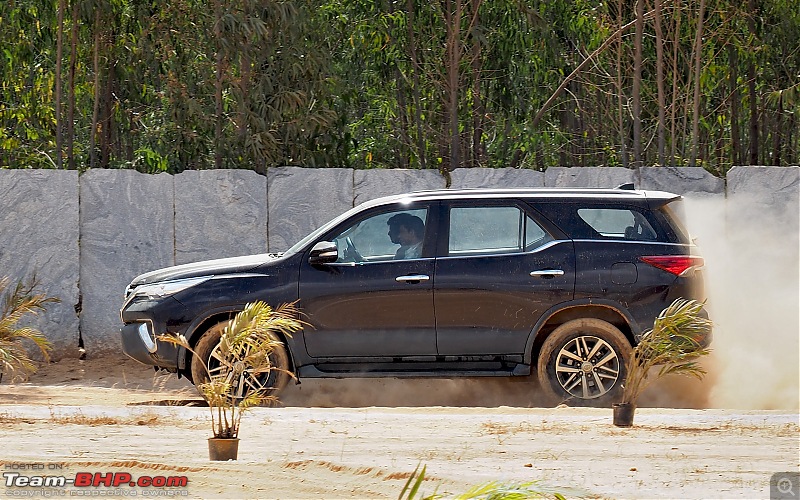 Here, drivers were allowed to take off at full torque to test the acceleration & stopping power on a dry dirt track. The straight track length was only 100 meters, so there was no danger of reaching high speeds. The Fortuner really impressed here, in both take off and braking. Between the Vehicle Stability Control (VSC) with Brake Assist (BA), Active Traction Control (A-TRC) and ABS with EBD, you would never know what kept you from sliding forward or sideways. 2) Hill Assist Control (HAC) and Downhill Assist Control (DAC) We had a sine wave-shaped artificial hill, starting with a deep and narrow trough in the ground.   As we got out of the trough, we faced a metal hill that played the crest of the sine wave.   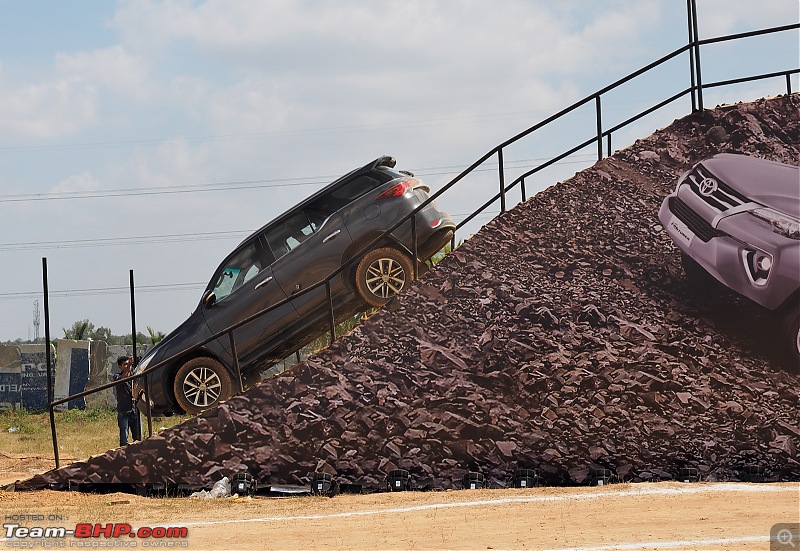 While entering the trough and while exiting the crest, we got to experience the 'downhill assist control' (DAC) feature. Upon engaging DAC and letting go of all the pedals, the car gently glided down the slope. This is hardly a surprising feature for any offroader. Similar behaviour can be seen in Jeeps in low range. But DAC will work in both - 4WD high and low range and in any gear, as long as the speed is below 30 km/h. While exiting the trough and while entering the crest, we got to experience the 'Hill Assist Control'. This is not really an offroad-only feature; it is quite useful when starting on an incline. While stopping on an incline, you can let go of the brake and the car doesn’t move back for 3 seconds. This gives the driver ample time to change gears and press the throttle without having to worry about rolling back down the hill. 3) Potholed Roads & Speed Bumps I don’t think anyone needs an explanation of these common phenomena on Indian roads! The ride was rather bumpy here, at least at the speed we were doing.   4) Water Fording The Fortuner is rated for fording 700 mm deep water. The 265/60 R18 tyres themselves are 775 mm tall and even they won’t be fully submerged!  The Fortuner's doors have a double-step sealing mechanism at the bottom, which keeps water out entirely.      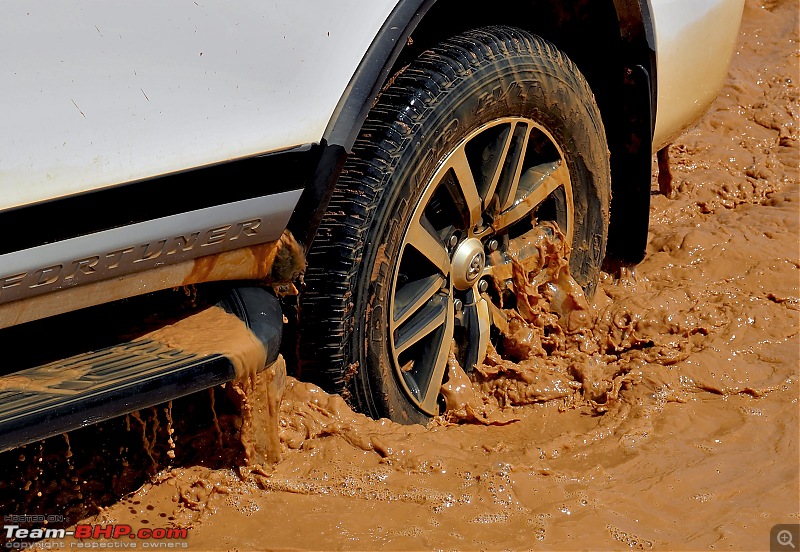 5) Axle Twister Here, the Fortuner had to drive through a series of uneven mounds that test the articulation and traction control system. As one wheel goes up in the air, it spins at first, which activates the traction control. Then, the freewheeling wheel stops, and torque is sent only to the opposite wheel, which is on the ground.   Large mirrors were strategically placed so that the driver could see himself in action.  6) Side Incline This was the most exciting obstacle for me, because it is the scariest act for any offroader. Tilting sideways is very uncomfortable, since there is no way to control it if overdone. Here at the track, they had a metal incline that was within the tilt specification of the Fortuner. Still, it was really scary to tilt such a large SUV to that degree.   This is how it looked in the mirror from inside the car.  7) Twisties Next up were a series of twisties to test the vehicle stability, handling and cornering. The Fortuner did well for its size. 8) Mud Crawling This is always challenging for heavy SUVs as they tend to get bogged down in deep mud. However, the Fortuner is loaded with so much torque that it just crawls through mud without any throttle input. The traction control eliminates all the wheel spin. The instructor asked me to leave the pedals alone and just deal with the steering. The Fortuner went through the entire mud section without any throttle input!  All in all, the Fortuner exceeded my expectations for a heavy SUV in offroad performance. And here is the final surprise. All the Fortuners here were running on highway tyres! Suffice to say, the 4x4 Fortuner will have far superior offroad behaviour on AT rubber. It's no mountain goat like a Jeep or Gypsy, yet the Fortuner's 4x4 capability is excellent for a big SUV.  Additional 4x4 observations from Jaggu (he drove it in Kerala): • The AT makes trails so easy. Just leave it in 4x4 mode and let the electronics do all the work. You only watch out for the ruts and ravines. • For a normal trail type drive with a little slush and rocks thrown in, 4x4 High is more than enough. Downside? You have to use the sequential or paddle shifters to keep the vehicle in low gear, so that it doesn’t shift up and run off. • Ride was bumpy at very slow speeds, so we decided to stop and put some space between us and the convoy to drive fast. Boy oh boy, it impressed us with its ride off the road. I have driven a fully decked up Pajero on the same route, and the new Fortuner could glide over the surface in a much easier fashion. • Completely off the road and at speeds over 20 km/h, the SUV ploughs ahead in comfort as long as you are able to manage those speeds. Although, crawling is advised with a tight seatbelt and firm grip on the grab handles. • 4x4 Low was next. The SUV will shift into L mode only if it comes to a stop and the AT is in 'N'. Please note that in P, it won’t engage (as I discovered). It will just keep flashing lights and blow a warning chime. This is a good safety feature to keep the tranny safe from abuse. With the Fortuner MT, you need to fully press the clutch before engaging 4x4 Low. • Crawl is amazing in 4x4 Low, it will put the Jeeps to shame!! The electronics work really well. • The hydraulic steering transmits quite a lot of terrain undulation back to your hands at slow speed. Whether you like it or not depends on how much 'feedback' you desire. • The suspension architecture and chassis upgrade for road use seem to be compromising the articulation aspects compared to the older car. The wheels started lifting even at the smallest of cross-axle obstacles. Post-drive photo with instructor Prithviraj:   Last edited by GTO : 25th January 2017 at 15:34. |
| |  (51)
Thanks (51)
Thanks
 |
| The following 51 BHPians Thank Samurai for this useful post: | ach1lles, Aditya, AJ-got-BHP, akshay81, AutoIndian, Avikbrio, avinash_clt, BlackPearl, CarguyNish, Contrapunto, DrANTO, ecosport rules, espraveen, GTO, iabhishekkumar, InControl, IronH4WK, Jaggu, JoseVijay, JTM, Leoshashi, libranof1987, mroptimist, MSAneesh, Mustang Sammy, NoMind, parsh, phoenixash, Prakritij, ragh_bhushan, RAHS, RavenAvi, Roy.S, Rshreyansh, sahibrain, Sankar, scopriobharath, sgmuser, Sheel, Simat, SnS_12, Srikanth@raj, T2luvroads, Teesh@BHP, Tejas@perioimpl, theexperthand, Turbanator, vaasu, vb-saan, Vid6639, vredesbyrd |
| | #13 |
| Team-BHP Support  | Other Points • Built in Bidadi, Karnataka with over 80% localisation. Toyota inaugurated a new diesel engine plant near Bangalore in 2016. • With better brakes, nicer interiors & a comfier ride, you could say that Toyota has sorted all the shortcomings of the 1st-gen Fortuner. With all these improvements, the Fortuner has just expanded its appeal (similar to the Endeavour). Won’t be surprised if it attracts some Euro-car aspirants too. On the other hand, it certainly won’t be a cakewalk for the SUV. The Innova Crysta has bridged the gap to its expensive sibling, while the new Ford Endeavour has gotten so darn competitive! • Thunderous opening response with 1,800 – 1,900 units / month dispatched from the factory in November & December. Will be interesting to see the level she settles at eventually. • On the MT, the 4x4 costs 2.53 lakh rupees more (that’s 3 lakhs on the road). On the AT, the 4x4 costs 1.98 lakhs more. Why this step-motherly treatment to the 4x4 MT? This kind of a steep premium means we'll be seeing very few 4x4 Fortuners on the road. That's a shame, considering its capability. • The Fortuner’s brand equity is such that people walk into a Toyota dealership to service their old Fortuner, and walk out with a new one!! link to BHPian's post. • Many features such as an auto dimming IRVM, auto folding ORVMs, front parking sensors, lumbar support for the driver’s seat and sunroof are missing. At this price point, these features are expected to be standard. Big mistake by Toyota. • Standard warranty of 3 years / 1,00,000 km. Toyota now offers extended warranties up to 7 years - full details here. As always, we strongly recommend the maximum coverage, even on a Toyota. Remember the Innova Crysta niggles thread? • It's ironical that a car that is classified as one of the 'most reliable' vehicles in India has to visit the service station more than other 'less reliable' models! The Fortuner diesel's service interval is just 5,000 km / 6 months (same as the previous-gen). This, in a time when most other models have convenient 10,000 km / 12 month visits (some even going up to 15,000 km). Toyota seriously needs to redesign the Fortuner's maintenance schedule. An owner with heavy running of 2,500 km / month will need to send his car to the workshop every 2 months! Absolutely ridiculous. • The first 3 services are labour-free. Initial intervals for the diesel are 1,000 km / 1 month, 5,000 km / 6 months and 10,000 km / 12 months. Initial intervals for the petrol are 1,000 km / 1 month, 10,000 km / 12 months and 20,000 km / 24 months. • Remember our 'mini-Land Cruiser' reference earlier in the review? Toyota acknowledges that, and tries to bank in on the big daddy's reputation. The Fortuner's brochure contains this line "...which exudes the same level of dependability & drivability as the Toyota Land Cruiser". • In 7 years, the price of the Fortuner has gone up by 63%! In 2009, the Fortuner 4x4 MT cost you 18.45 lakhs. Today, a 4x4 MT is priced at 30.05 lakhs. • ARAI fuel efficiency ratings: Diesel AT - 12.9 km/l; Diesel MT - 14.24 km/l; Petrol AT - 10.26 km/l; Petrol MT - 10.01 km/l. • Something strange about the quoted wheelbase length. The Innova Crysta, old Fortuner & old Innova all have a 2,750 mm wheelbase. On the new Fortuner though, the spec sheet & website read its length at 2,745 mm. We find this difference to be hard to believe. Even the owner's manual says that the wheelbase is 2,750 mm long! • If you want to be chauffeur-driven, there’s no doubt that an Innova Crysta with those awesome captain seats will be the more comfortable option. • Available in 7 colours - Phantom Brown (our test car), Attitude Black, Silver Metallic, Grey Metallic, Super White, Avant Garde Bronze & White Pearl Crystal Shine. • Doors auto lock at 25 km/h. What's more, they will automatically unlock in an accident. • I insist, beige interiors should definitely have been an option. A large part of the market still prefers beige as it results in a lighter, airier cabin. For the record, Toyota offers lighter coloured leather upholstery in markets such as Australia. • Scored a 5 star safety rating in the Latin NCAP & ANCAP crash tests. Obtained 33.95 / 37 points and a "Good" remark in the latter  . . • For a car that focuses so much on safety, not having a TPMS (tyre pressure monitoring system) is inexplicable. Big miss, Toyota. At the end of the day, safety levels all come down to those 4 palm-sized tyre patches in contact with the road. • Engine timing chain is for life. No periodic replacement required. • All important buttons are illuminated, including the ECO / PWR / TC off buttons, steering-mounted controls, power window switches etc. • Has the follow-me-home feature. Switch off the car and flash the high beam, it'll then stay on for 30 seconds while you find your way in the dark. • The durability of Toyota body-on-frame diesels is such that, people complete 2 lakh kms and think nothing of holding onto them for another lakh kms - related post. • When you lock & unlock the car, there is no confirmation beep. Lock the car and the turn indicators flash once; unlock the car and they flash twice. • Try to walk away from the Fortuner with the engine running + the smartkey in your pocket, and you'll hear short beeps on the outside. Try to lock the door at the same time and you'll hear a long continuous beep. • The instrument cluster has five levels of adjustment. It's tricky to adjust the illumination, so I'll explain it here. First, press the plastic stalk on the instrument cluster till you see the illumination option at the bottom of the MID. Then, long press on the stalk. It'll now keep jumping between the different levels. Stop when you get to the desired level. • A lot of people think that the ECO & PWR modes only alter throttle response. That’s certainly not true and the system is clearly more than that. Among other things, even the behaviour of the climate control system & power steering changes a bit. At the time of the Innova Crysta’s drive, Toyota had told us that ECO mode brings a power drop of between 8 - 10%. Therefore, again, it’s more than just altering the throttle behaviour. • Like the old Fortuner’s smaller 2.5L variant, I’m sure that we’ll see a cheaper 2.4L variant here (engine borrowed from the Innova Crysta). • The windows - and even the electric tailgate - have jam protection. • Remember we spoke of the tailgate's memory function? Here's how to set it up: a) Stop the tailgate in the desired position by pressing the open / close button (keyfob / dashboard switch) b) Press and hold the open/close button on the tailgate for about 2 seconds c) You will hear 4 beeps when the memory function is set d) Next time the tailgate opens, it will stop in this position • Disclaimer: Toyota invited Team-BHP for the Fortuner test-drive. They covered all the travel expenses for this driving event. Last edited by GTO : 25th January 2017 at 15:33. |
| |  (39)
Thanks (39)
Thanks
 |
| The following 39 BHPians Thank Aditya for this useful post: | AJ-got-BHP, akshay81, Avikbrio, bj96, BlackPearl, CarguyNish, ecosport rules, GTO, InControl, IronH4WK, Jaggu, JoseVijay, Leoshashi, libranof1987, mroptimist, MSAneesh, noopster, parsh, phoenixash, Prakritij, PraNeel, R2D2, RAHS, raihan, ramgkulkarni, RavenAvi, roby_dk, Roy.S, Rshreyansh, sahibrain, Sankar, Sheel, Simat, SnS_12, Stratos, theexperthand, Turbanator, vb-saan, Vid6639 |
| | #14 |
| Team-BHP Support  | The Smaller yet Significant Things Powerful Bi-beam LED headlamps illuminate the road very well:  With the high beam engaged, the throw is phenomenal!  Automatic dimming for the IRVM is shockingly missing in such an expensive car! Standard manual adjuster is provided – the kind you get in economy hatchbacks:  Wood-finished area of the steering has grooves for your fingers to get a grip:  Horn discs are located high up in the engine bay. The tone sounds rather feeble when you are inside the car with the windows rolled up. But open up the windows and you’ll notice that it's lost none of its strength - a good demonstration of the overall noise insulation inside the cabin:  Even if you haven't accessed the navigation or entered a destination, the MID's compass screen shows you the name of the road you're currently on. Your knowledge of city roads will certainly improve!  Rubber flap to cover the steering column's innards. I like Hyundai's leather treatment more (link to image):  Diesel fuel flap gets a small red sticker as a reminder of its diet. Won’t be needed as much as the…  …white sticker on the petrol. Fuel pump attendants automatically assume that this truck is a diesel, so please ensure that the right fuel is filled in. The big black “P” has been applied by the dealership on our media car as an added security measure!  ORVMs are India-friendly and they move the other way with minimal resistance. Literally, it's one-finger light!  Small yet bright reversing lights on the extreme sides:  The inside rubber beading (on the body & pillars) is of excellent quality:  Two solar / sunlight sensors on the dashboard. One is used by the climate control system, the other by the 'auto headlamps':  Alarm indicator light on the left of the dashboard flashes when the system is set: 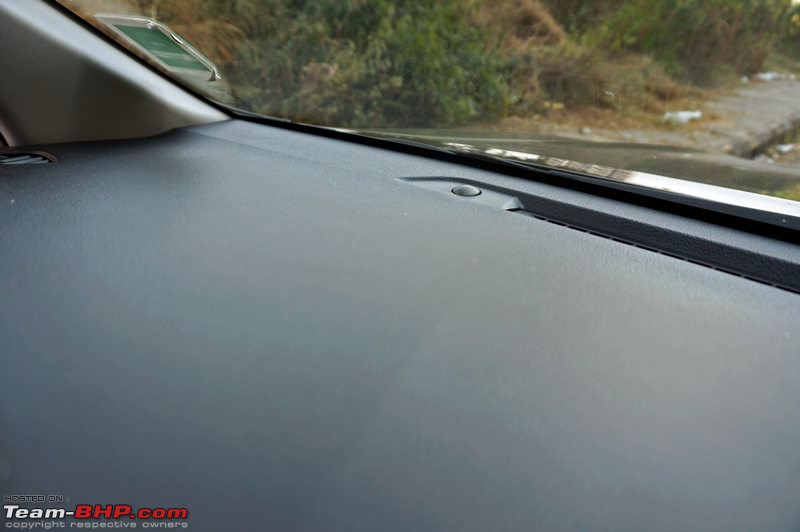 Don’t make the mistake of completely removing the rubber flap on the USB and Aux-in ports. Fitting it back is a real pain:  A 'Fortuner' image is displayed at startup:  Cruise control sign appears on the top right of the MID when the feature is activated: 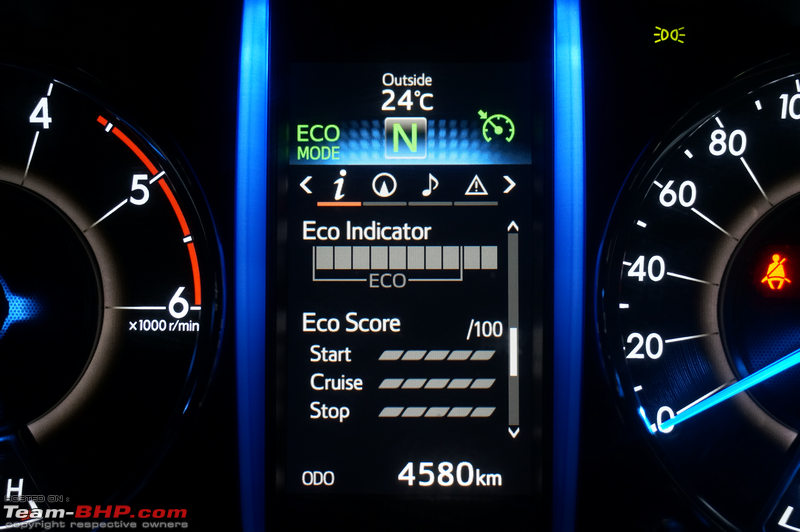 White OBD port is located under the steering column:  Things are universally organised, even in places you wouldn't normally look. This is the front passenger's footwell:  Twist & turn locks to hold the floor mats in place:  You don't ever need to take the black & chrome smartkey out of your pocket, thanks to the passive keyless entry and go. Backside gets Fortuner branding:  Heavy owner's manual runs nearly 600 pages long! Then, there's a separate one for the navigation:  Drive with a light foot and you'll see a yellow ECO light on the rev counter. It's very small and easy to miss. Not an indicator you'll see in your peripheral vision:  Last edited by GTO : 25th January 2017 at 15:32. |
| |  (42)
Thanks (42)
Thanks
 |
| The following 42 BHPians Thank Aditya for this useful post: | AJ-got-BHP, akshay81, AutoIndian, Avikbrio, BlackPearl, CarguyNish, DrANTO, ecosport rules, GTO, honey_starhoney, iabhishekkumar, InControl, IronH4WK, Jaggu, JoseVijay, JTM, karuvally, Leoshashi, libranof1987, mroptimist, MSAneesh, noopster, parsh, phoenixash, Phoneix, Prakritij, PraNeel, PrasunBannerjee, R2D2, ragh_bhushan, RavenAvi, Rshreyansh, Sankar, scopriobharath, Sheel, Simat, SnS_12, Teesh@BHP, theexperthand, Turbanator, vb-saan, Vid6639 |
| | #15 |
| Distinguished - BHPian  | A Fortuner Owner's Perspective  • I just bought the new Fortuner, and still own my 2010 previous-gen Fortuner. • The exterior design philosophy of the new Fortuner uses Toyota's "Keen Look" design with the slim projector LED headlamps & DRLs. Honestly, the car looks much better in person & the design grows on you. • The ORVMs of the 1st gen Fortuner were more truck-like, which I miss. • The new GD series is based on the KD block, with improvements of course. Upon digging for more information, I got to know that it has about 11% better air flow, and a 30% smaller sized turbo which is 50% faster in response. • After extensively driving the new Fortuner, I believe the new GD block is quieter. • Even though the torque is less in the manual variant compared to the AT, the manual feels quicker. • There is not much difference in the Normal & ECO Modes. • Power Mode definitely makes the car respond much faster and does justify being called POWER MODE. On the flip side, the ride does get jerky in Power Mode, and the car also acts a bit snappy. • The AT diesel is noisier compared to the MT as the AT at lower speeds is gear hunting. • In continuation of the above observation, the new Fortuner still feels better on refinement compared to the older gen. Partly also as the top-mounted intercooler is gone and there's no hood vent, hence Toyota gets to do a complete engine bay damping which wasn't there in the previous-gen. • The new 6-speed manual gearbox is a joy to use. Gone is the long truck-like gear stick of the older gen, which I miss as it was such an integral part of the entire 'truck-like feel' of the Fortuner. But this new 6-speed transmission from the RC series of Toyota is extremely pleasurable to use as shift quality is vastly improved over the previous-gen and the throws are now shorter too. • The gear ratios of the 6-speed MT have been optimised to feature a 10% lower 1st gear for enhanced low-speed torque delivery, with a 23% higher ‘top gear’ providing greater fuel efficiency and relaxed high speed cruising. • Torque kicks in from a very low 1,400 rpm; excellent for driveability. • It is best to engage 6th gear only after 80 km/h, else vibrations start filtering into the cabin. • The manual also gets the 'Intelligent Manual Transmission (iMT)' feature which effectively incorporates rev-matching on both, upshifts & downshifts, to provide an ultra-smooth drive as well as assisting with smoother clutch release. Do note this feature is a world-first in this segment. • Getting FE of 13-14 km/l is very easy on the highway, even after maintaining healthy speeds. City FE is about 10 km/l. Overall efficiency appears to be better than the Endeavour 3.2. • The braking is vastly improved over the previous-gen, thanks to the addition of rear disc brakes. It definitely helps when driving fast as you can brake later. • Ride quality has become better. • The pitch & bounce control feature helps to maintain better ride quality too, as it uses wheel-speed sensor information to establish when the nose of the vehicle is either lifted or lowered by road surface undulations. In order to prevent excessive fore & aft movement of occupants, engine torque is increased when the nose of the vehicle dips, and conversely decreased when the nose lifts. This helps to smoothen out the ride. • The manual models miss out on 2 cupholders which are present in the AT (in front of the gear lever). • The bright white LED headlamps have great illumination and are a much needed upgrade in this 2nd gen car. • Fortuner sadly misses out on the ambient lighting which the Innova Crysta has. Why? • The ORVM puddle lamps & boot lamp are yellow in colour, but all other interior lights are white. Why? • Ingress & egress into the new Fortuner is slightly more difficult compared to the previous-gen as it feels taller. • The interiors are a vast improvement compared to the previous-gen. Everything seems well put together - as expected from Toyota - and feels built to last. • The view / visibility from the driver's seat is commanding, just like the previous-gen. • The steering is nice to hold and they have got the haptics right with a mix of wood, leather & metal. I'm glad they have retained the old-school hydraulic steering, which goes well with this brute body-on-frame SUV. • Touchscreen sensitivity is good, but there is a delay. It's like it wants to beep first & react later. This experience should have been better. • The interior leather shade is 'Dark Brown' which almost looks like black at night. This colour shade is not the best of what Toyota has. I prefer the Fawn (tan) shade, which is offered in the Australian & South African versions. • The front seat's side-bolstering has improved and feels a touch sporty. • Middle row comfort has increased, especially the thigh support. Better low to mid back support from the reclining seat. • Middle seat (5th passenger) now gets a headrest. This was not there in the 1st-gen Fortuner. • Middle row armrest is now centered, whereas in the previous-gen, the armrest was more towards the right side. • The rear A/C control switches feel much more premium to operate (compared to the previous-gen). • Last row remains as spacious as the previous-gen, but the headroom has reduced as the roof seems protruding downwards (to accommodate the boot lamp). There was a boot lamp in the last-gen too, but without any such downward protrusion. • Surprisingly, the tyres on the 4x4 variants are H/T and jokingly, the 4x2 variants get A/Ts. Dumb move by Toyota. • Tyre pressure of the 1st-gen Fortuner was 30 PSI; this time, the recommended tyre pressure has dropped to 29 PSI. • Thai-spec Fortuner's TRD variant gets bold 20" rims with 265/50 R20 tyres. Will that be offered in the upcoming TRD Sportivo variant? Will be interesting to watch. • The electronic drive control switch / knob is easy to operate, but the old-school mechanical lever will be missed. • Couldn't really test the 4x4 artillery yet. Did some simple trails, which were a walk in the park for the new Fortuner. • The Indian version misses out on rear diff locks. • The ground clearance has now increased by 4 mm to 225 mm (vs previous-gen's 221 mm). • Losing out on full-time 4WD may not inspire confidence. • The new key is nicely finished. With features like electric boot open / close & keyless entry, it surely is convenient. • Navigation is a welcome feature, although it seems that they picked the wrong lady for giving out directions. She sounds like a middle-aged school teacher. • Good to see a total of 7 airbags on offer compared to only 2 in the previous-gen. • The safety kit includes Vehicle Stability Control (VSC) with Brake Assist (BA), ABS with Electronic Brake Distribution (EBD), Hill Hold Assist, Downhill Assist Control and ISOFIX seats (2nd row). • The Hill Hold Assist can get irritating for someone who knows how to release the clutch on a slope and doesn't need its assistance. I say this because you cannot switch off this assistance!! • In the Indian market, the only accessories offered by the dealers are chrome housings & such cosmetic garnishes, whereas Australian & South African dealers are offering superb add-ons like bullbars, snorkels, winches, TRD rims etc. This is really unfair. Conclusion: Overall, I believe Toyota have a winner on their hands as the previous-gen Fortuner was getting old and lacked modern features & equipment. This new Fortuner adds all of that, and still is the TRUCK that the Fortuner always was...but in a more liveable avatar. With Fortuner sales recently crossing the 1,00,000 mark, the launch of the new Fortuner is going to surely propel sales further. My Video Review: |
| |  (60)
Thanks (60)
Thanks
 |
| The following 60 BHPians Thank karan561 for this useful post: | Aditya, AJ-got-BHP, AutoIndian, Avikbrio, avinash_clt, bhp, bj96, BlackPearl, BNM, CarguyNish, CarLoverJosh, carrot_eater, daretodream, dean5545, DrANTO, ecosport rules, GTO, honey_starhoney, InControl, IronH4WK, jacobvarughese, Jaggu, JoseVijay, JTM, kedarwalke, Leoshashi, libranof1987, Manan_02, man_of_steel, MAS, mayank0782, mroptimist, MSAneesh, Mu009, Mustang Sammy, nareshtrao, parsh, phoenixash, Phoneix, Prakritij, PraNeel, PrasunBannerjee, R2D2, ragh_bhushan, RAHS, RavenAvi, roby_dk, Rshreyansh, sahibrain, Sankar, SDP, Sheel, Simat, SnS_12, Sommos, supertinu, theexperthand, Turbanator, vb-saan, Vid6639 |
 |

